

Johns Hopkins University (JHU) continues to pad its space community résumé with their interactive map, “The map of the observable Universe”, that takes viewers on a 13.7-billion-year-old tour of the cosmos from the present to the moments after the Big Bang. While JHU is responsible for creating the site, additional contributions were made by NASA, the European Space Agency, the National Science Foundation, and the Sloan Foundation.
OSIRIS-REx is the third mission in NASA's New Frontiers Program. Its goal is to explore near-Earth asteroid Bennu, a remnant from the dawn of the solar system, and to return a sample of Bennu to Earth in 2023. OSIRIS-REx launched in September 2016 and arrives at Bennu on December 3, 2018. This video illustrates each of the mission's carefully-designed orbit maneuvers and mapping campaigns on its journey to Bennu and back. This video is public domain and along with other supporting visualizations can be downloaded from the Scientific Visualization Studio at: Visualization Studio at: Credit: NASA's Scientific Visualization Studio If you liked this video, subscribe to the NASA Goddard YouTube channel: http://www.youtube.com/NASAExplorer Follow NASA’s Goddard Space Flight Center · : Facebook · Twitter · Flickr · Instagram Full Credits Dan Gallagher (USRA): Producer Walt Feimer (KBRwyle): Lead Animator Michael Lentz (USRA): Animator Kel Elkins (USRA): Data Visualizer Adriana Manrique Gutierrez (USRA): Animator Josh Masters (USRA): Animator Lisa Poje (USRA): Animator Bailee DesRocher (USRA): Animator Dante Lauretta (University of Arizona): Scientist Jason Dworkin (NASA/GSFC): Scientist Category Science & Technology

Paging Bruce Willis! NASA is planning to launch a probe to study an asteroid that could one day pulverize the Earth.
The asteroid, named Bennu, crosses Earth’s orbit once every six years and has gotten ever closer since it was discovered in 1999,
astronomers told the Sunday Times of London (paywall). In 2135, Bennu will fly between the moon and Earth — a hair’s breadth in space terms,
the Times reported. That’s so close that gravity from the Earth could effect Bennu’s orbit,
“potentially putting it on course for the Earth later that century,” said Dante Lauretta, a professor of planetary science at Arizona University.
Bennu is about 1,600 feet in diameter.
Published on Sep 7, 2016 NASAs OSIRIS-REx spacecraft is on a mission to explore asteroid Bennu and return a sample to Earth.
The OSIRIS-REx launch window opens on September 8, 2016, when the spacecraft begins its two-year journey to Bennu
aboard an Atlas V rocket at Cape Canaveral, Florida. After arriving at Bennu in 2018, OSIRIS-REx will spend over a year
exploring the asteroid before approaching its surface to grab a sample. This pristine material, formed
at the dawn of the solar system, will be returned to Earth in 2023, providing clues to Bennus origins and our own.
NASAs Goddard Space Flight Center in Greenbelt, Maryland, provides overall mission management,
systems engineering and safety and mission assurance for OSIRIS-REx. Dante Lauretta is the missions principal
investigator at the University of Arizona. Lockheed Martin Space Systems in Denver built the spacecraft.
OSIRIS-REx is the third mission in NASAs New Frontiers Program. NASAs Marshall Space Flight Center in Huntsville, Alabama,
manages New Frontiers for the agencys Science Mission Directorate in Washington.
Official trailer for NASAs OSIRIS-REx mission to asteroid Bennu. Credit: NASA's Goddard Space Flight Center/David Ladd More information: This video is public domain and along with other supporting visualizations can be downloaded from the Scientific Visualization Studio If you liked this video, subscribe to the NASA Goddard YouTube channel:
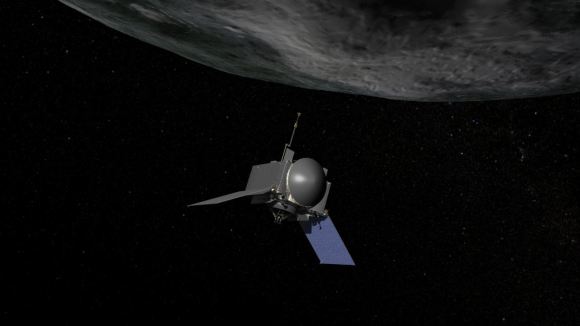
Artist concept of OSIRIS-REx, the first U.S. mission to return samples from an asteroid to Earth. Credit: NASA/Goddard
OSIRIS-Rex, NASA�s first ever spacecraft designed to collect and retrieve pristine samples of an asteroid for
return to Earth has entered its final assembly phase.
Approximately 17 months from now (April 2015), OSIRIS-REx is slated to launch in the fall of 2016
and visit asteroid Bennu, a carbon-rich asteroid.
MISSION BRIEF
Published on May 19, 2013 NASA's FY2014 budget proposal includes a plan to robotically capture a small near-Earth
asteroid and redirect it safely to a stable lunar orbit where astronauts can visit and explore it.
The proposed mission would combine the efforts of three NASA mission directorates:
Human Exploration and Operations, Science and Space Technology. Category Science & Technology License Standard YouTube License
by Ken Kremer on April 1, 2015
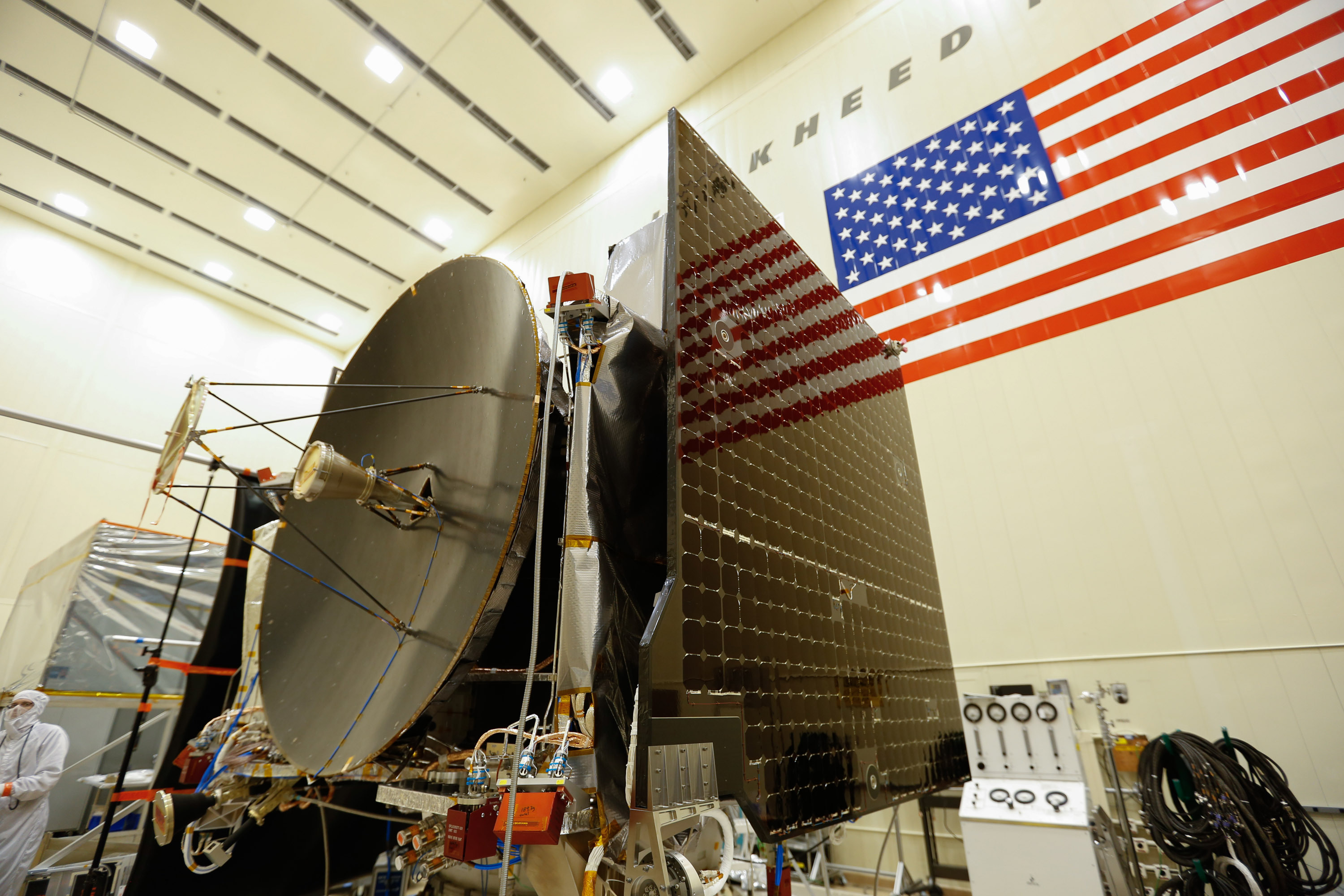
The high gain antenna and solar arrays were installed on the OSIRIS-REx spacecraft prior to it moving to environmental testing. Credits: Lockheed Martin Corporation
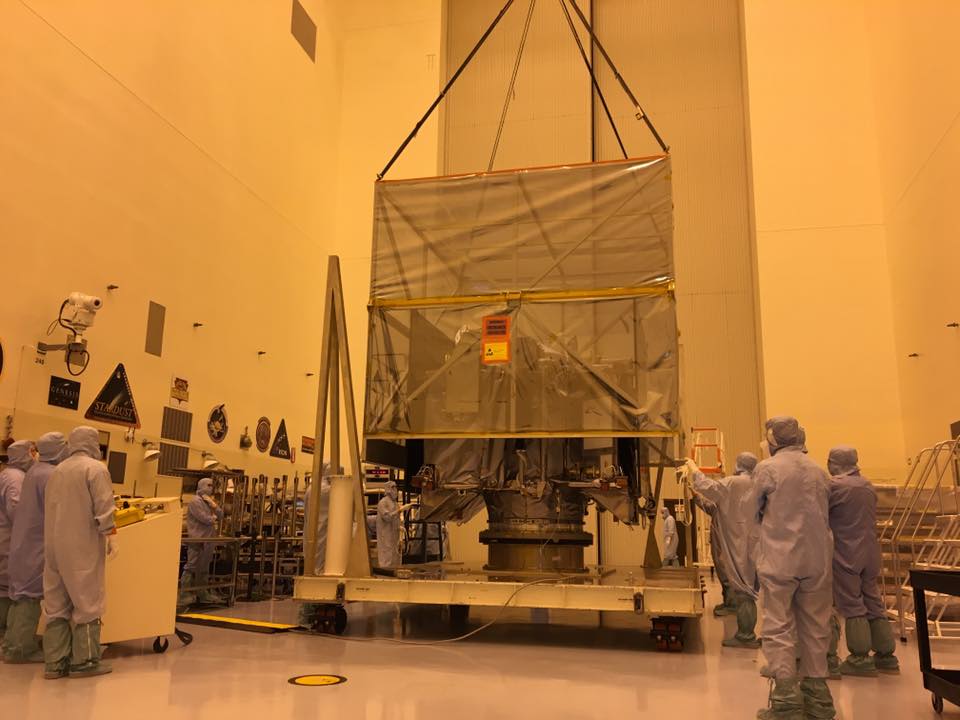
Inside the Payloads Hazardous Servicing Facility high bay at NASA’s Kennedy Space Center,
engineers are removing “the birdcage” a soft, protective cover from over the Osiris-REx spacecraft.
Credit: NASA OSIRIS-Rex – has arrived at its Florida launch base for processing to get ready for blastoff barely three and one half months from today.(Late May 2016)
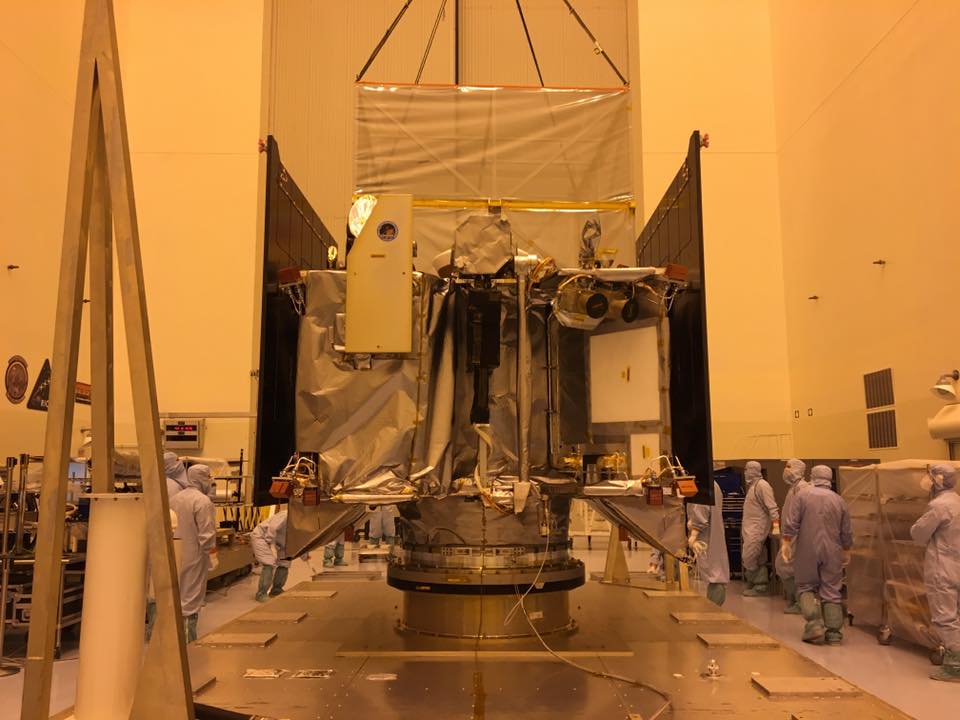
Inside the Payloads Hazardous Servicing Facility high bay at NASA’s Kennedy Space Center,
engineers are removing “the birdcage” a soft, protective cover from over the Osiris-REx spacecraft.
Credit: NASA
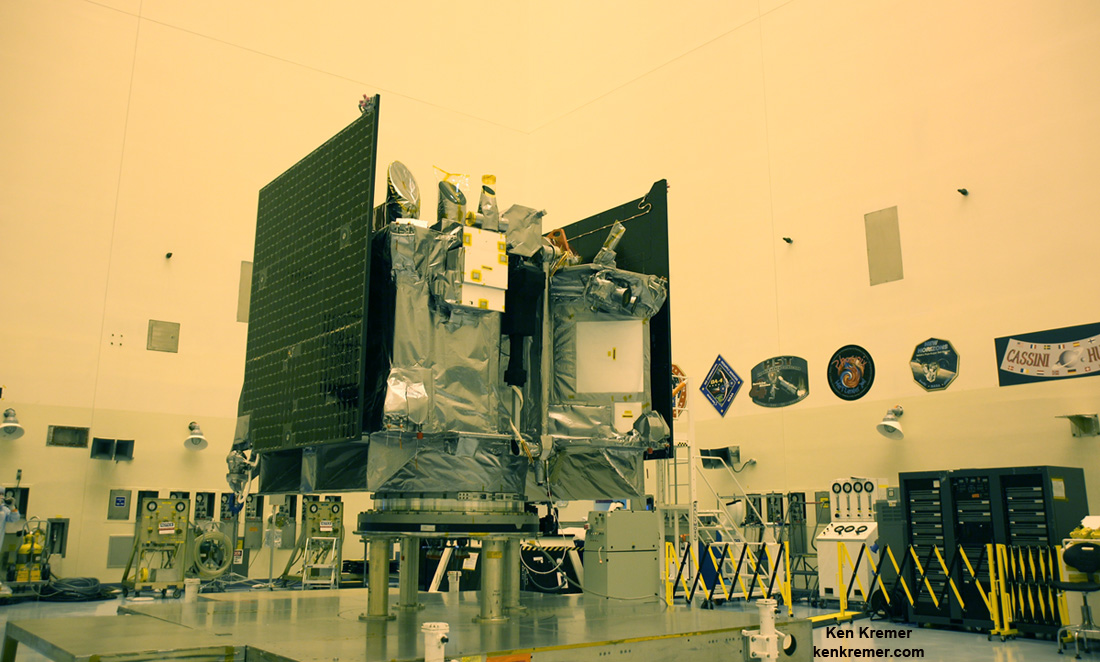
View of science instrument suite and TAGSAM robotic sample return arm on NASA’s OSIRIS-REx asteroid sampling spacecraft
inside the Payloads Hazardous Servicing Facility at NASA’s Kennedy Space Center. Probe is slated for Sep. 8, 2016 launch
to asteroid Bennu from Cape Canaveral Air Force Station, FL.
Credit: Ken Kremer
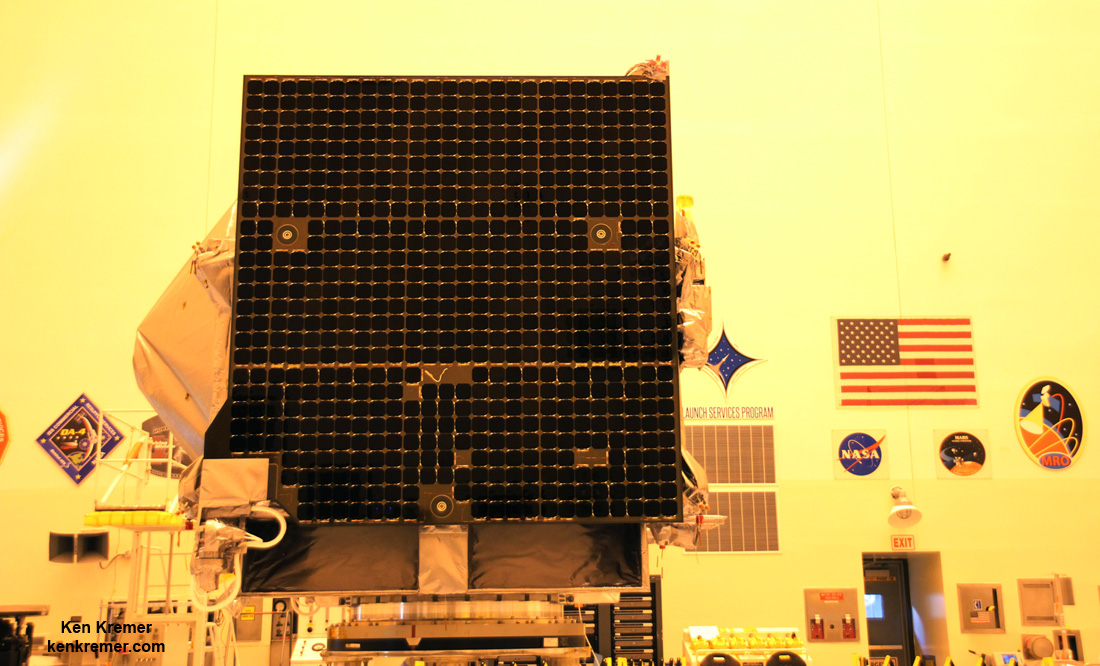
Side view of NASA’s OSIRIS-REx asteroid sampling spacecraft showing the High Gain Antenna at left and solar panel,
inside the Payloads Hazardous Servicing Facility high bay at NASA’s Kennedy Space Center.
Probe is being processed for Sep. 8, 2016 launch to asteroid Bennu from Cape Canaveral Air Force Station, FL. Credit: Ken Kremer
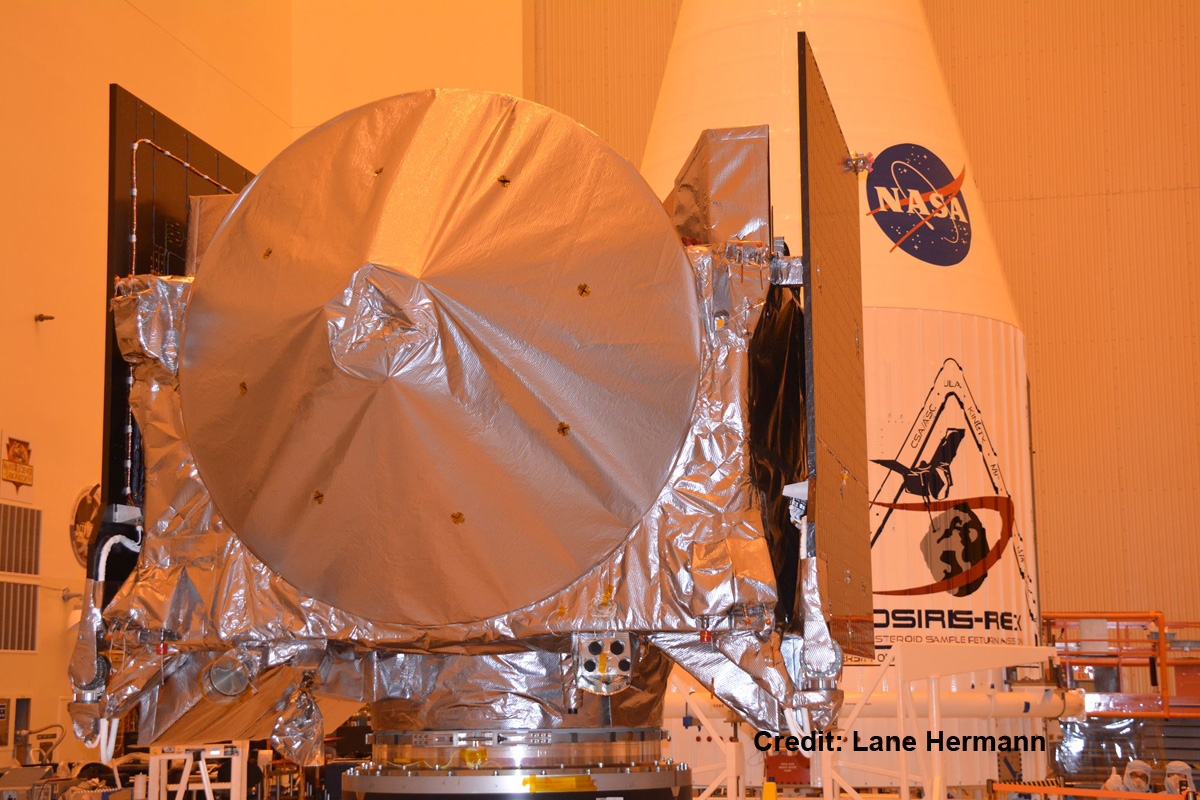
NASA’s OSIRIS-Rex asteroid sampling spacecraft inside the Payloads Hazardous Servicing Facility high bay
at NASA’s Kennedy Space Center. Launch is slated for Sep. 8, 2016 to asteroid Bennu from Cape Canaveral Air Force Station, FL.
Credit: Lane Hermann
Published on Aug 21, 2016 Our first introduction to the asteroid bound mission in search of the origins of life. You will be hearing and reading
a lot about OSIRIS-REX launching Sept. 8th. Very impressive super clean PHSF. We are a US disabled veteran run,
non profit video production company who's mission is to bring other disabled US Veterans to witness a launch,
experience US Space History and become part of our report. Our nonprofit 501(c)(3) is 100% tax deductible,
just go to our webpage which is merged with and find our Donate button. You can help change the life of a US Veteran. Thank You Category Science & Technology License Standard YouTube License

NASA’s OSIRIS-REx asteroid sampling spacecraft, return capsule and payload fairings inside the Payloads Hazardous Servicing Facility
high bay at NASA's Kennedy Space Center is being processed for Sep. 8, 2016 launch to asteroid Bennu from Cape Canaveral, FL.
Credit: Ken Kremer
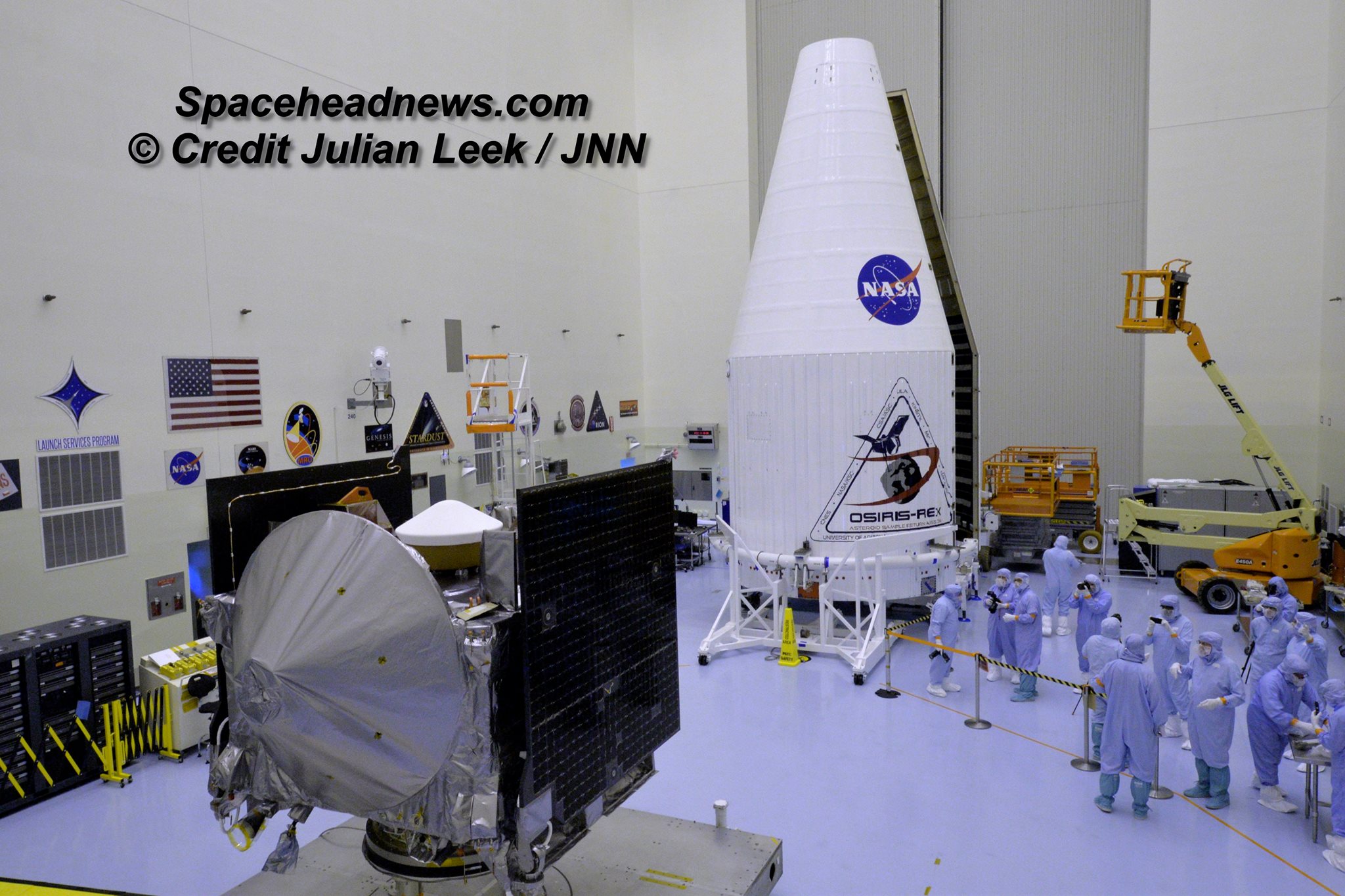
Overhead view of NASA’s OSIRIS-REx asteroid sampling spacecraft with small white colored sample return canister atop,
inside the Payloads Hazardous Servicing Facility high bay at NASA’s Kennedy Space Center.
Launch is slated for Sep. 8, 2016 to asteroid Bennu from Cape Canaveral Air Force Station, FL.
Credit: Julian Leek
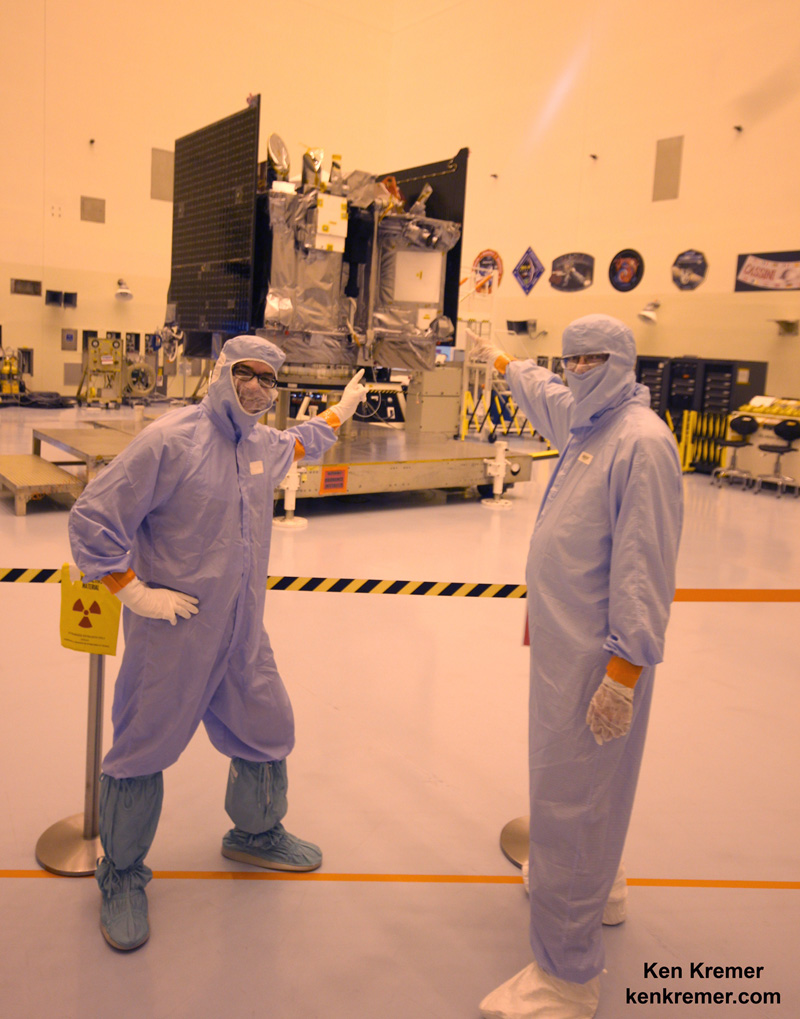
Dr Dante Lauretta, principal investigator for OSIRIS-REx at the University of Arizona, Tucson,
and Dr. Ken Kremer, Universe Today point to NASA’s OSIRIS-Rex asteroid sampling spacecraft inside
the Payloads Hazardous Servicing Facility at the Kennedy Space Center on Aug. 20, 2016. Credit:
Credit: Ken Kremer
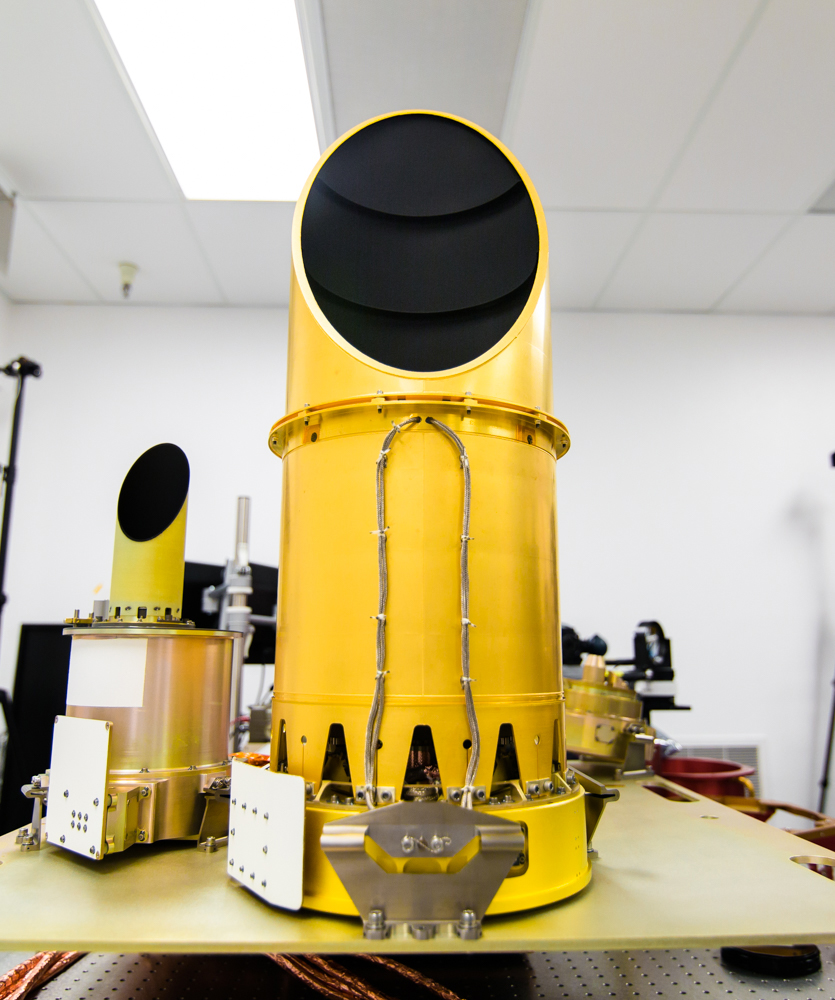
The University of Arizona’s camera suite, OCAMS, sits on a test bench that mimics its arrangement
on the OSIRIS-REx spacecraft. The three cameras that compose the instrument –
MapCam (left), PolyCam and SamCam – are the eyes of NASA’s OSIRIS-REx mission.
They will map the asteroid Bennu, help choose a sample site, and ensure that the sample is correctly stowed on the spacecraft.
Credits: University of Arizona/Symeon Platts

Image: The Origins, Spectral Interpretation, Resource Identification, Security-Regolith Explorer (OSIRIS-REx)
spacecraft will travel to a near-Earth asteroid, called Bennu (formerly 1999 RQ36), and bring at least a 60-gram sample
back to Earth for study. The mission will help scientists investigate how planets formed and how life began,
as well as improve our understanding of asteroids that could impact Earth.
Credit: NASA/University of Arizona.
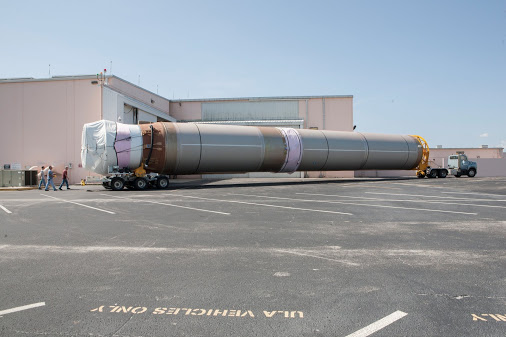
OSIRIS-REx Atlas V rocket is at NASA Kennedy Center. Here is the first stage Common Core Booster!
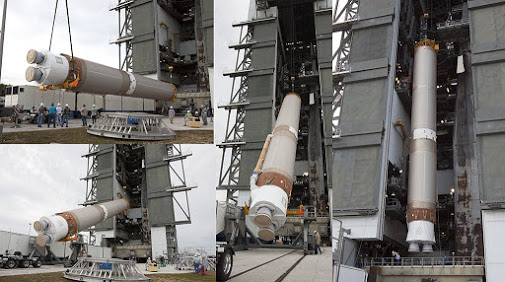
OSIRIS-REx Timelapse - Rollout
Published on Sep 7, 2016 Hey everyone, we're down at Cape Canaveral for the OSIRIS-REx launch, which takes off tomorrow. We're making a longer video to let you come along, but we captured this cool timelapse. Stay tuned... A timelapse of the OSIRIS-REx moving from the VIF to the launchpad. Category Science & Technology License Standard YouTube License

NASA’s OSIRIS-REx asteroid sampling spacecraft is rolled out to pad 40 for launch atop a
United Launch Alliance Atlas V rocket on Sept. 8, 2016 from Space Launch Complex 41 on
Cape Canaveral Air Force Station, FL. Credit: Ken Kremer/
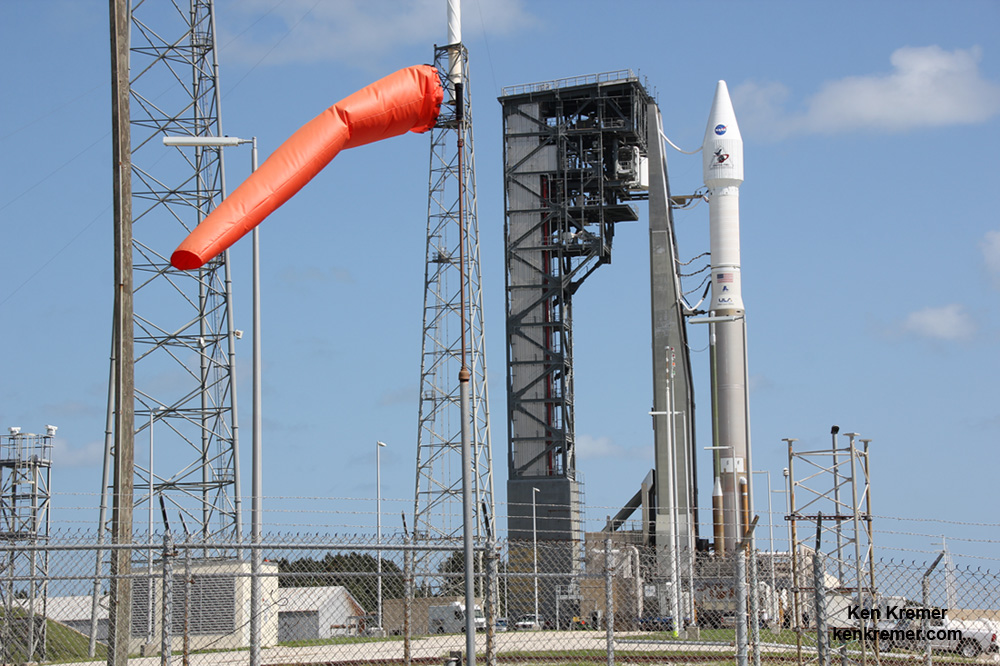
NASA’s OSIRIS-REx asteroid sampling spacecraft is rolled out to pad 40 for launch atop a
United Launch Alliance Atlas V rocket on Sept. 8, 2016 from Space Launch Complex 41
on Cape Canaveral Air Force Station, FL. Credit: Credit: Ken Kremer/
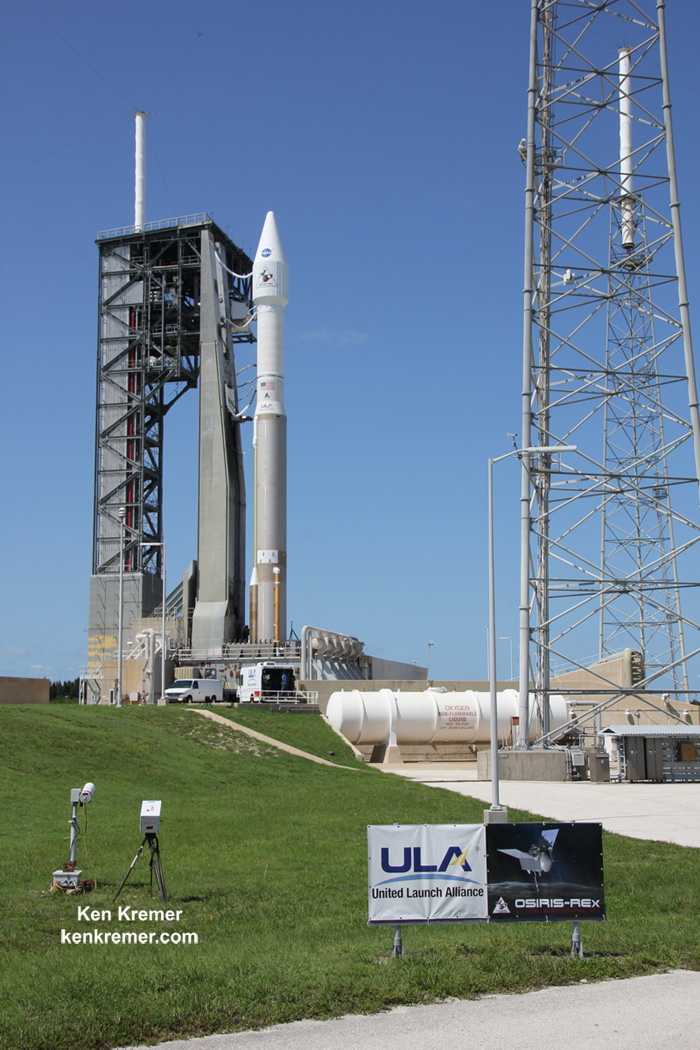
NASA’s OSIRIS-REx asteroid sampling spacecraft is poised for liftoff on a 7 year Journey
to asteroid Bennu and Back atop a United Launch Alliance Atlas V rocket on Sept. 8, 2016
from Space Launch Complex 41 on Cape Canaveral Air Force Station, FL.
Credit: Ken Kremer/
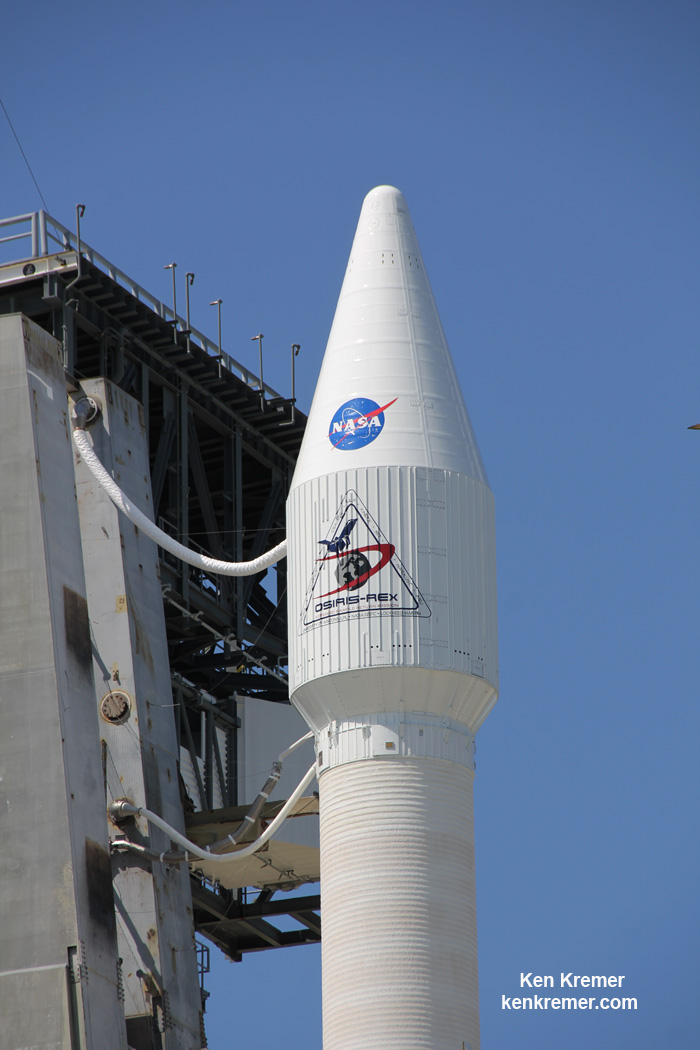
NASA’s OSIRIS-REx asteroid sampling spacecraft is housed inside the payload fairing
atop the United Launch Alliance Atlas V rocket on Sept. 8, 2016 from Space Launch Complex 41
on Cape Canaveral Air Force Station, FL. Credit: Ken Kremer/
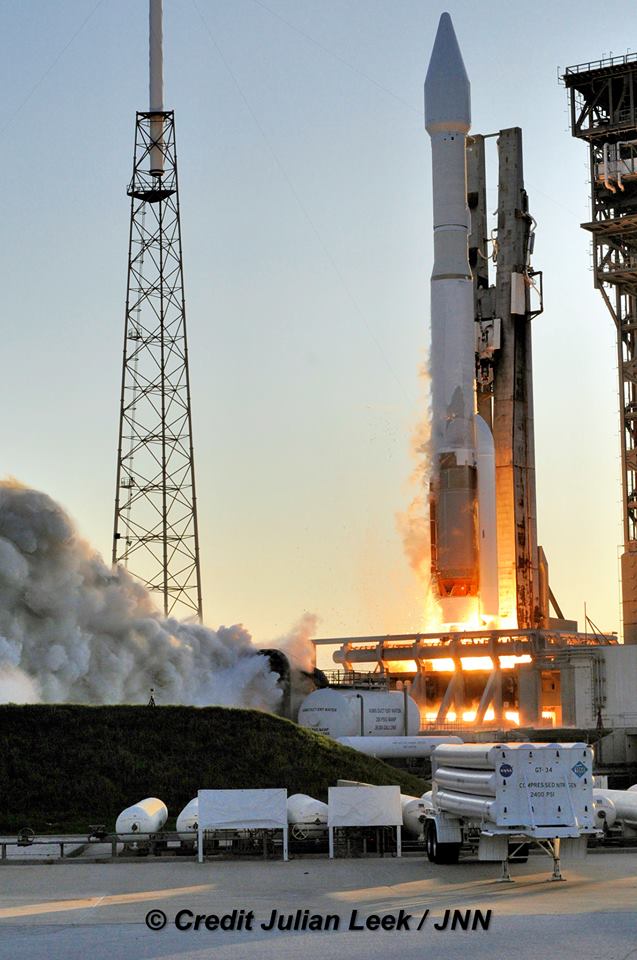
Liftoff of NASA’s OSIRIS-Rex asteroid sampling spacecraft on September 8, 2016
from Cape Canaveral Air Force Station, FL.
Credit: Julian Leek
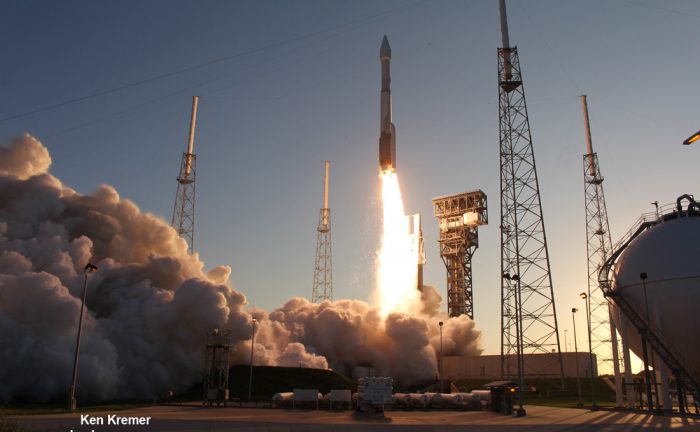
ULA Atlas V rocket lifts off on September 8, 2016 from Space Launch Complex 41 at Cape Canaveral Air Force Station
carrying NASA’s OSIRIS-REx asteroid sampling spacecraft, in this remote camera view taken from inside the launch pad perimeter.
Credit: Ken Kremer/
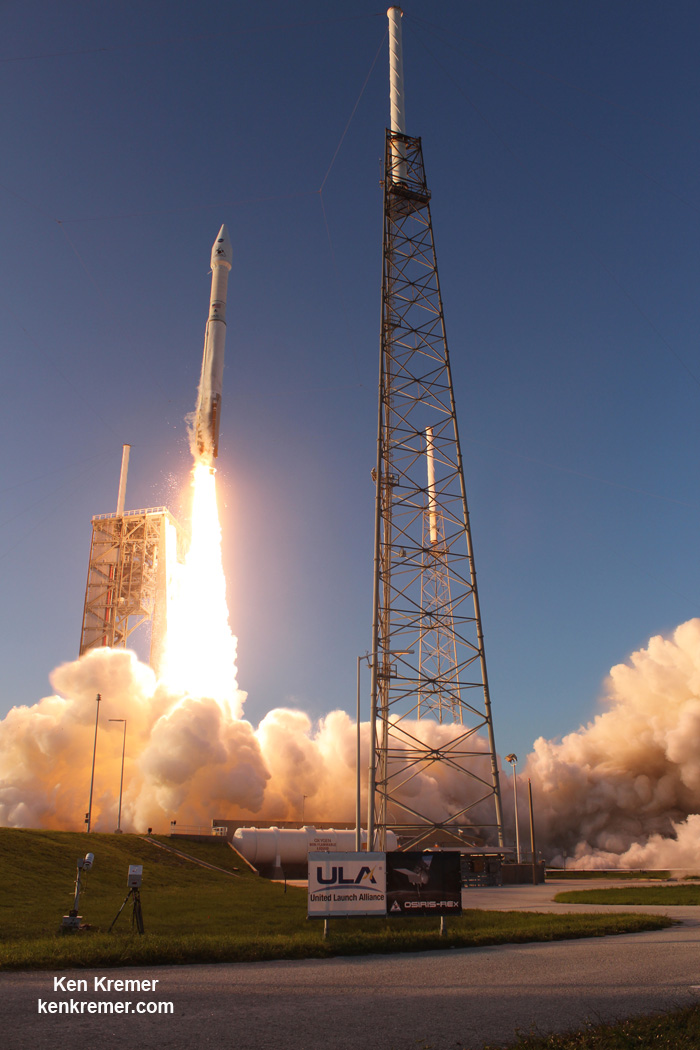
United Launch Alliance Atlas V rocket lifts off from Space Launch Complex 41 at
Cape Canaveral Air Force Station carrying
NASA’s Origins, Spectral Interpretation, Resource Identification, Security-Regolith Explorer, or OSIRIS-REx spacecraft
on the first U.S. mission to sample an asteroid, retrieve at least two ounces of surface material and return it to Earth for study.
Liftoff was at 7:05 p.m. EDT on September 8, 2016 in this remote camera view taken from inside the launch pad perimeter.
Note the newly install crew access arm and white room for astronaut flights atop Atlas starting in early 2018.
Credit: Ken Kremer/
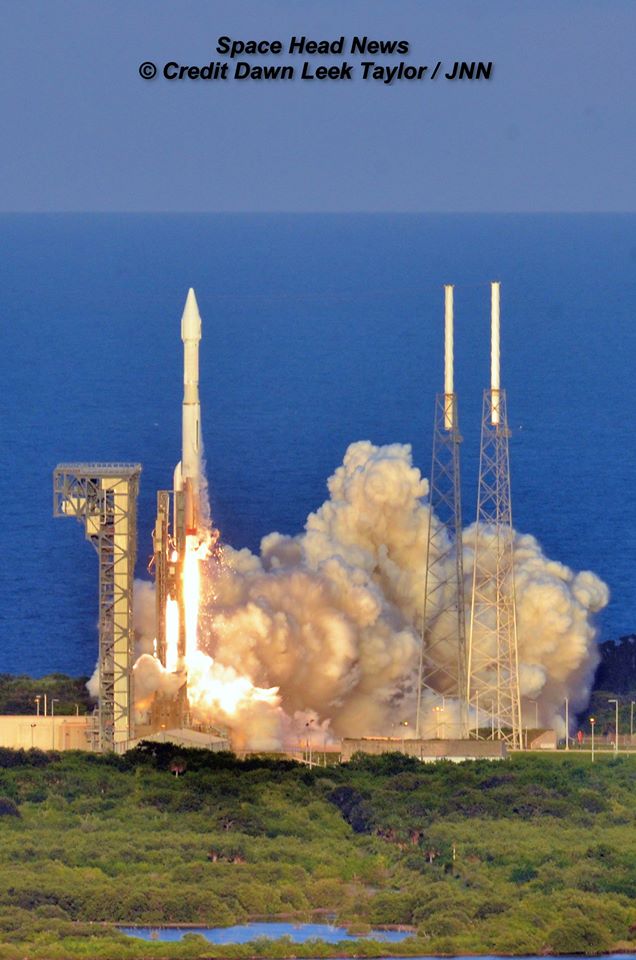
Liftoff of NASA’s Origins, Spectral Interpretation, Resource Identification, Security-Regolith Explorer,
or OSIRIS-Rex asteroid sampling spacecraft on September 8, 2016 from Cape Canaveral Air Force Station, FL.
Credit: Dawn Leek Taylor
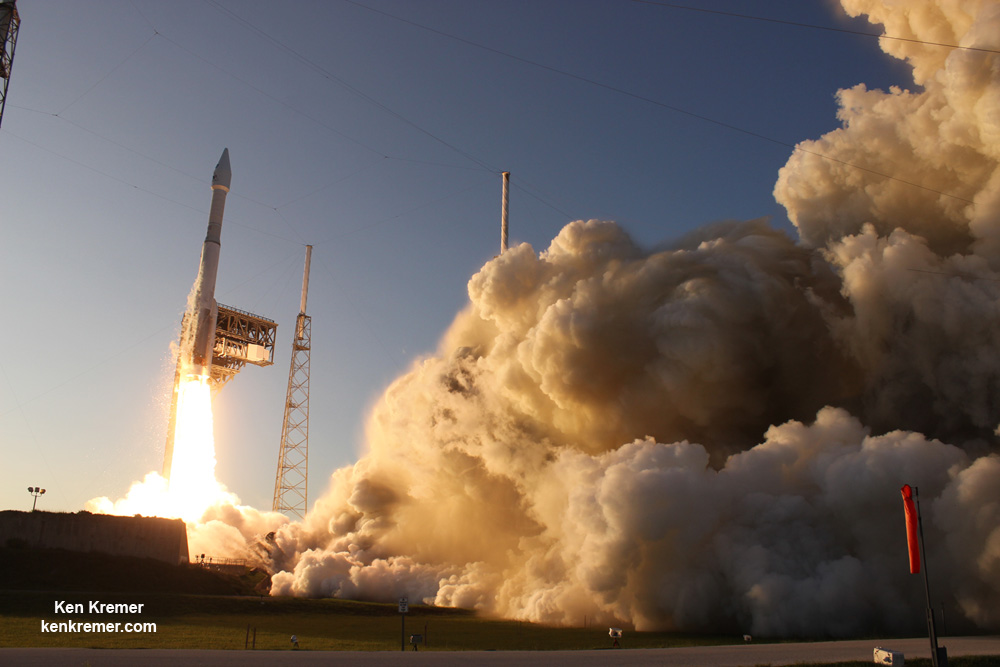
Liftoff of NASA’s Origins, Spectral Interpretation, Resource Identification, Security-Regolith Explorer,
or OSIRIS-Rex asteroid sampling spacecraft on September 8, 2016 from Cape Canaveral Air Force Station, FL.
Credit: Ken Kremer
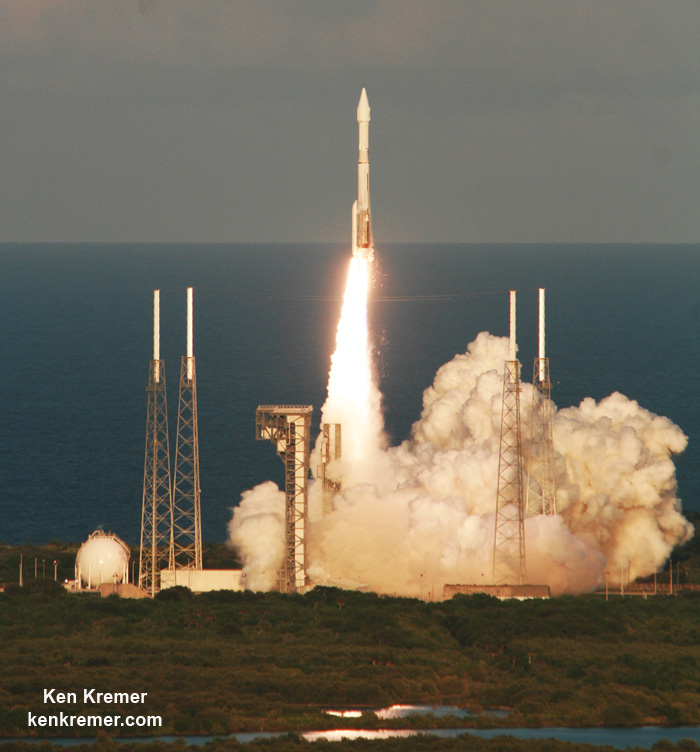
A United Launch Alliance Atlas V rocket lifts off from Space Launch Complex 41 at Cape Canaveral Air Force Station carrying NASA’s
Origins, Spectral Interpretation, Resource Identification, Security-Regolith Explorer,
or OSIRIS-REx spacecraft on the first U.S. mission to sample an asteroid, retrieve at least two ounces
of surface material and return it to Earth for study. Liftoff was at 7:05 p.m. EDT on September 8, 2016. Credit: Ken Kremer
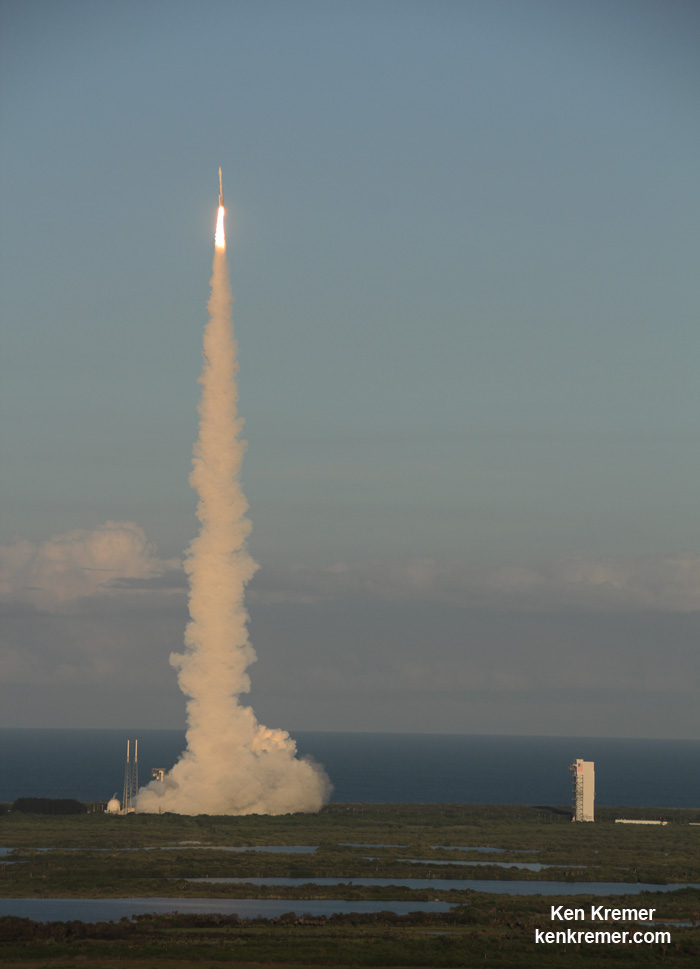
A United Launch Alliance Atlas V rocket lifts off from Space Launch Complex 41 at Cape Canaveral Air Force Station
carrying NASA’s Origins, Spectral Interpretation, Resource Identification, Security-Regolith Explorer,
or OSIRIS-REx spacecraft on the first U.S. mission to sample an asteroid, retrieve at least two ounces
of surface material and return it to Earth for study. Liftoff was at 7:05 p.m. EDT on September 8, 2016. Credit: Ken Kremer
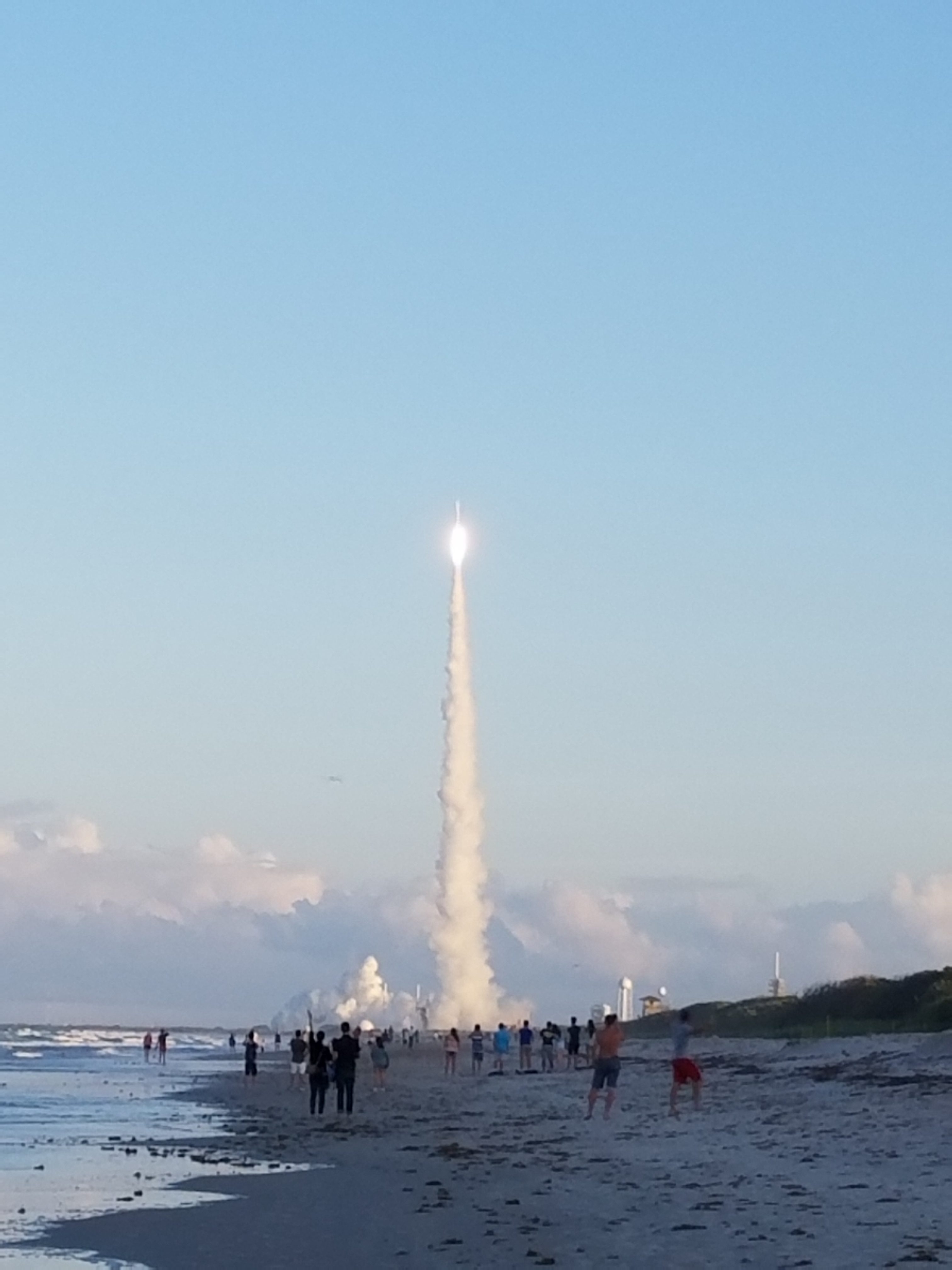
Blastoff of NASA’s OSIRIS-Rex asteroid sampling spacecraft on September 8, 2016 from Cape Canaveral Air Force Station, FL
as seen from Playalinda Beach. Credit: Jillian Laudick
Uploaded on Sep 13, 2016 Compilation of my launch videos from the ULA Atlas 5 launch in support of the NASA OSIRIS_REx asteroid sample return mission to the asteroid Bennu (#101955). It was launched on September 8th, 2016 from Pad 41 of CCAFS. It is scheduled to land in UTAH with asteroid samples on September 24, 2023. Category Science & Technology License Standard YouTube License
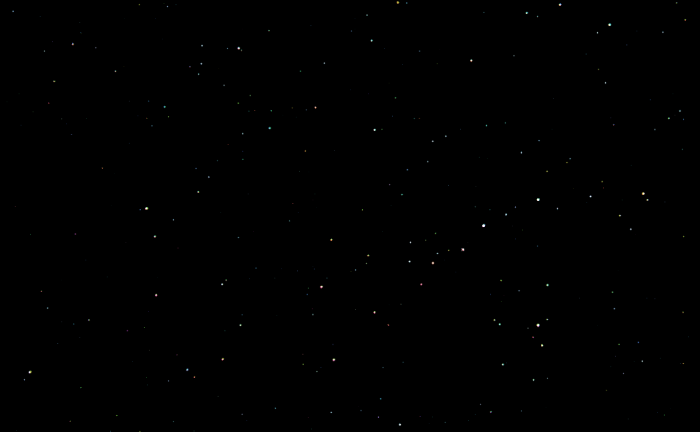
On Sept. 19, 2016 the OCAMS MapCam camera recorded a star field in Taurus, north of the constellation Orion
as part of the OSIRIS-REx spacecraft’s post-launch instrument check.
Credits: NASA/Goddard/University of Arizona
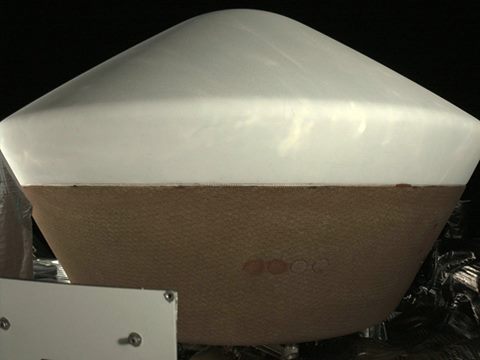
Image of OSIRIS-Rex Sample Return Capsule taken by StowCam instrument on Sept. 22, 2016,
two weeks after launch, during initial science instrument checkout at a distance of 3.9 million miles (6.17 million km)
away from Earth.
Credit: NASA
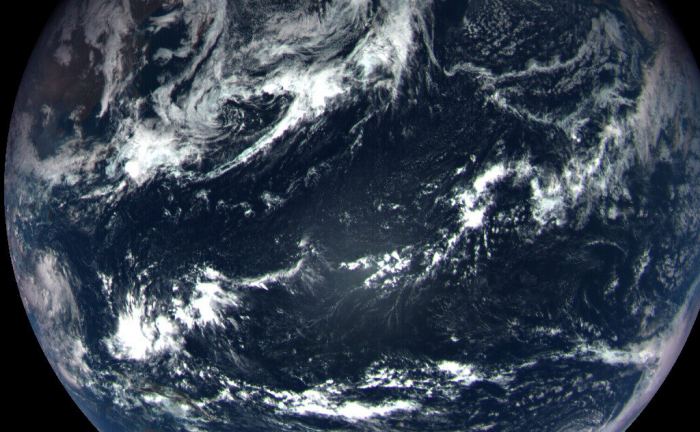
A color composite image of Earth taken on Sept. 22, 2017 by the MapCam camera on NASA’s OSIRIS-REx spacecraft just hours after the spacecraft completed its Earth Gravity Assist at a range of approximately 106,000 miles (170,000 kilometers). Credit: NASA/Goddard/University of Arizona
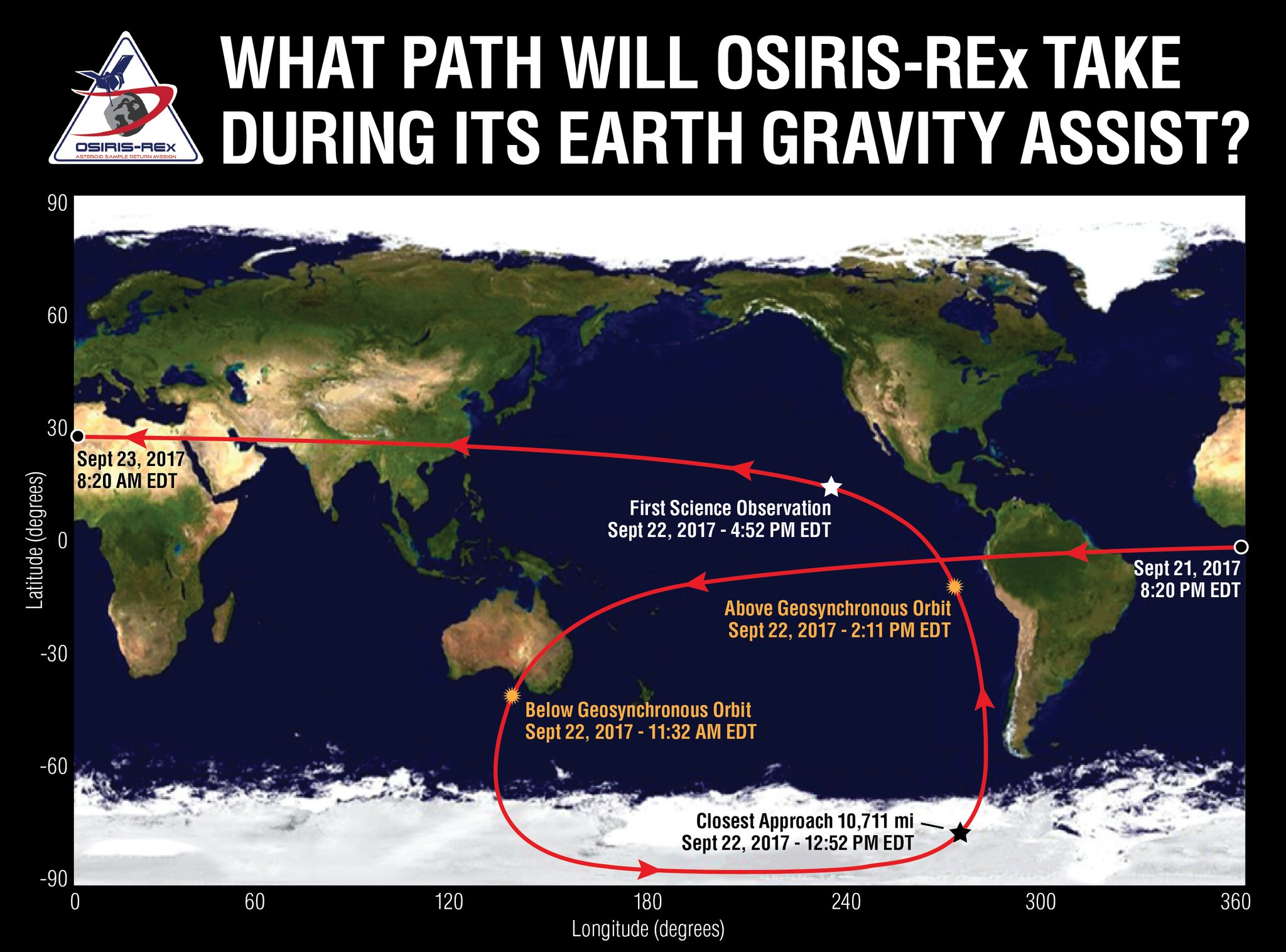
OSIRIS-REx flight path over Earth’s surface during the Sept. 22, 2017 slingshot over Antarctica at 12:52 a.m. EDT targeting the probe to Asteroid Bennu in August 2018. Credits: NASA’s Goddard Space Flight Center/University of Arizona
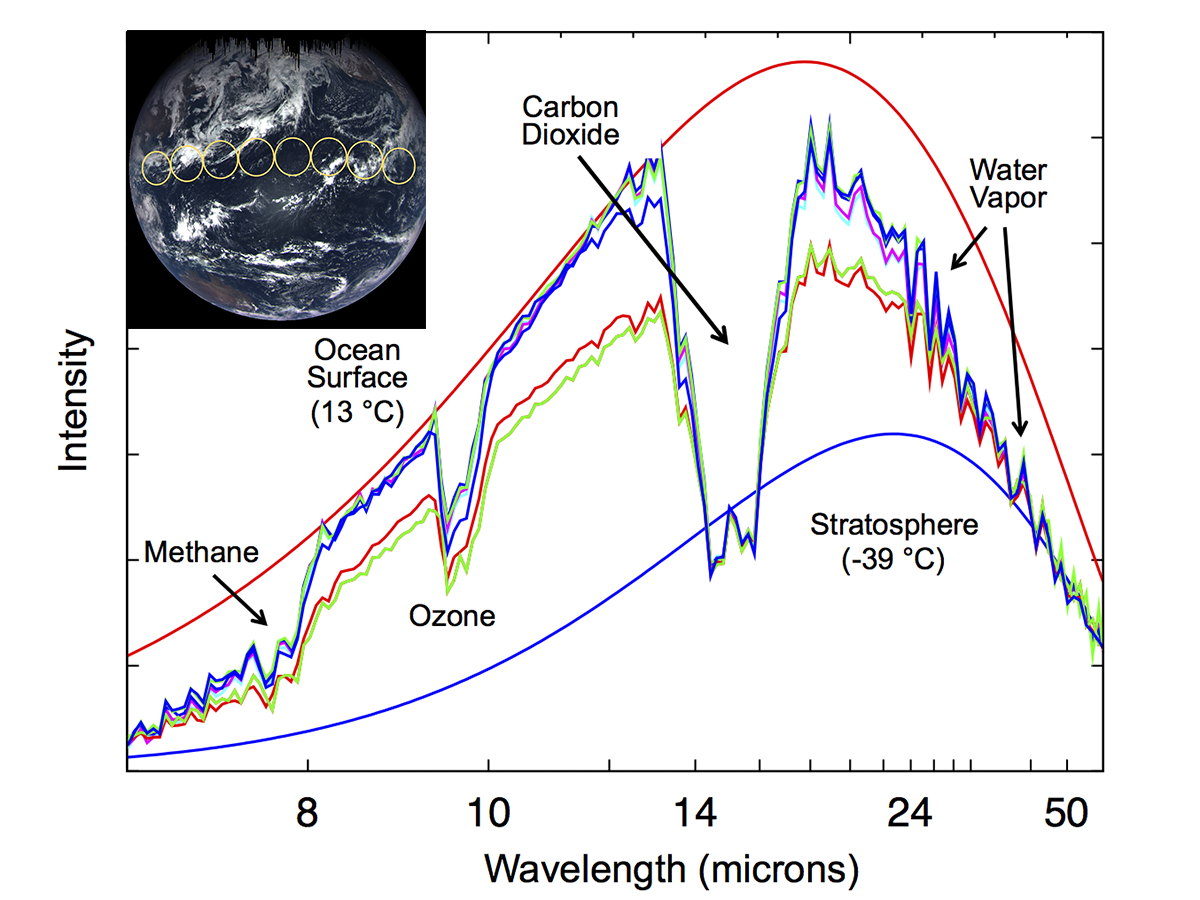
NASA’s OSIRIS-REx spacecraft OTES spectrometer captured these infrared spectral curves during Earth Gravity Assist on Sept. 22 2017, hours after the spacecraft’s closest approach. Credit: NASA/Goddard/University of Arizona/Arizona State University
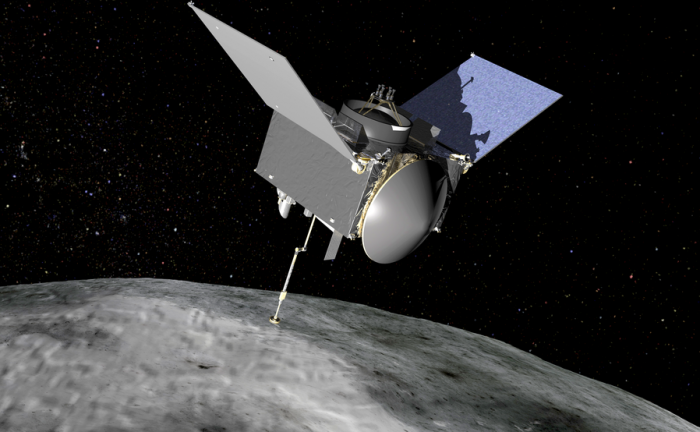
Artist’s conception of NASA’s OSIRIS-REx spacecraft at Bennu. Credits: NASA/GSFC America’s first ever mission designed to retrieve samples from the surface of an asteroid and return them to Earth –
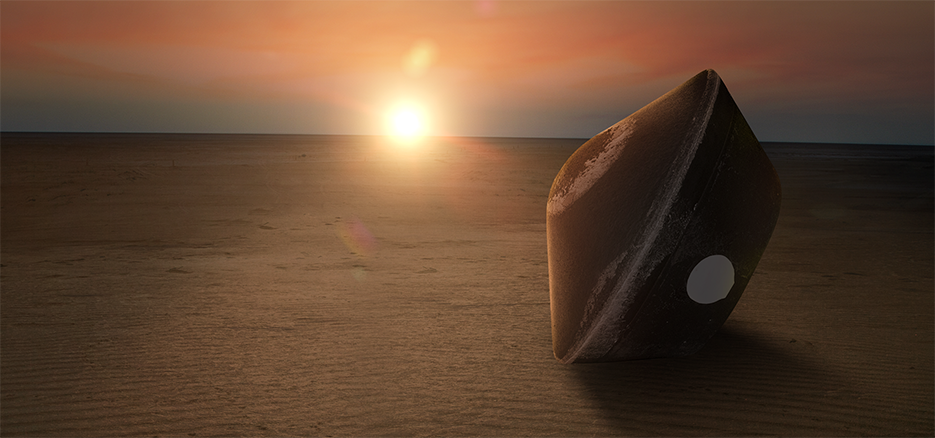
After a 7 year journey to asteroid Bennu and back, NASA’s OSIRIS-Rex sample return capsule
will land by parachute in the Utah desert on Sept. 24, 2023.
Credits: NASA/Lockheed Martin
January 2018

The Earth-Moon system, as imaged by NASA's OSIRIS-REx mission. Credit: NASA/OSIRIS-REx team and the University of Arizona
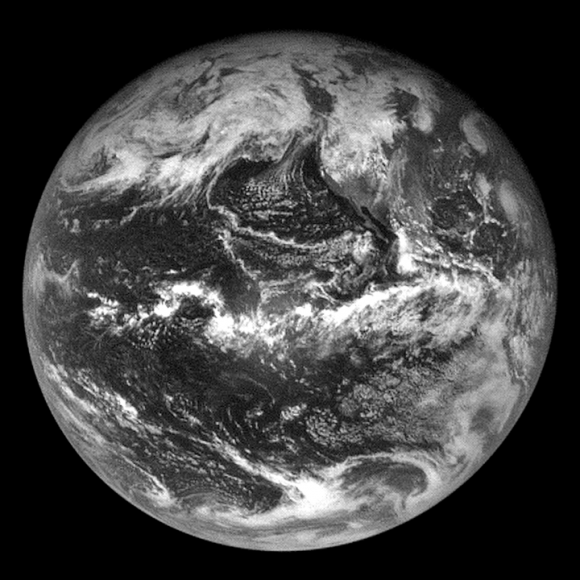
Black and white image of Earth taken by the OSIRIS-REx’s NavCam 1 instrument. Credit: NASA/OSIRIS-REx team and the University of Arizona
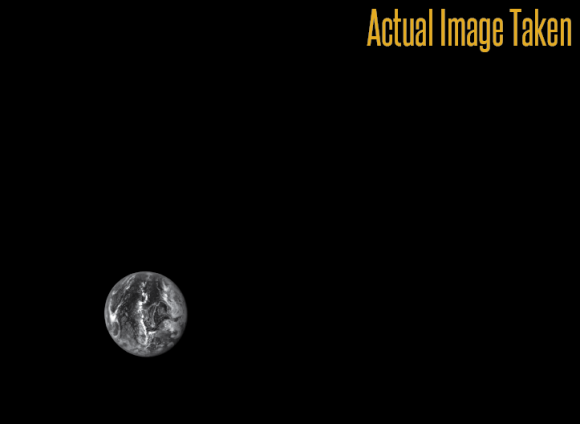
Original image taken by the OSIRIS-REx NavCam 1 of Earth. Credit: NASA/Goddard/University of Arizona/Lockheed Martin
OSIRIS-REx is NASA's mission to explore near-earth asteroid Bennu, collect a sample, and return it to Earth. To get to Bennu, however, OSIRIS-REx must first leave the plane of Earth's orbit and match the orbital tilt of its target. On September 22, 2017, OSIRIS-REx will approach Earth and fly over its southern hemisphere, passing within 11,000 miles of Antarctica. This gravitational slingshot will bend its trajectory by six degrees, sending the spacecraft on a path to intercept Bennu. Shortly after the flyby, OSIRIS-REx will look back at Earth and take images and spectra, ensuring that its instruments are ready for arrival at Bennu in 2018. Music provided by Killer Tracks: "Origin" This video is public domain and along with other supporting visualizations can be downloaded from the Scientific Visualization Studio at: Credit: NASA's Goddard Space Flight Center/Dan Gallagher If you liked this video, subscribe to the NASA Goddard YouTube channel: Follow NASA’s Goddard Space Flight Center · Facebook: · Twitter · Flickr · Instagram · Google+ Category Science & Technology License Standard YouTube License SHOW LESS
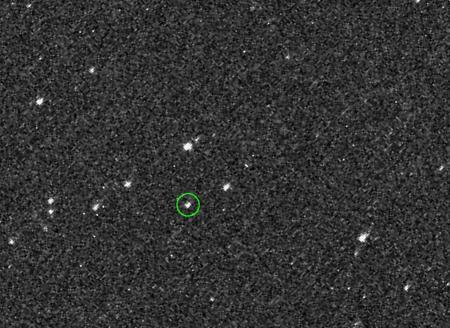
On Aug. 17, 2018, NASA’s OSIRIS-REx spacecraft obtained the first images of its target asteroid, Bennu, from a distance of 1.4 million miles (2.2 million km), or almost six times the distance between the Earth and moon. Credit: NASA/Goddard/University of Arizona
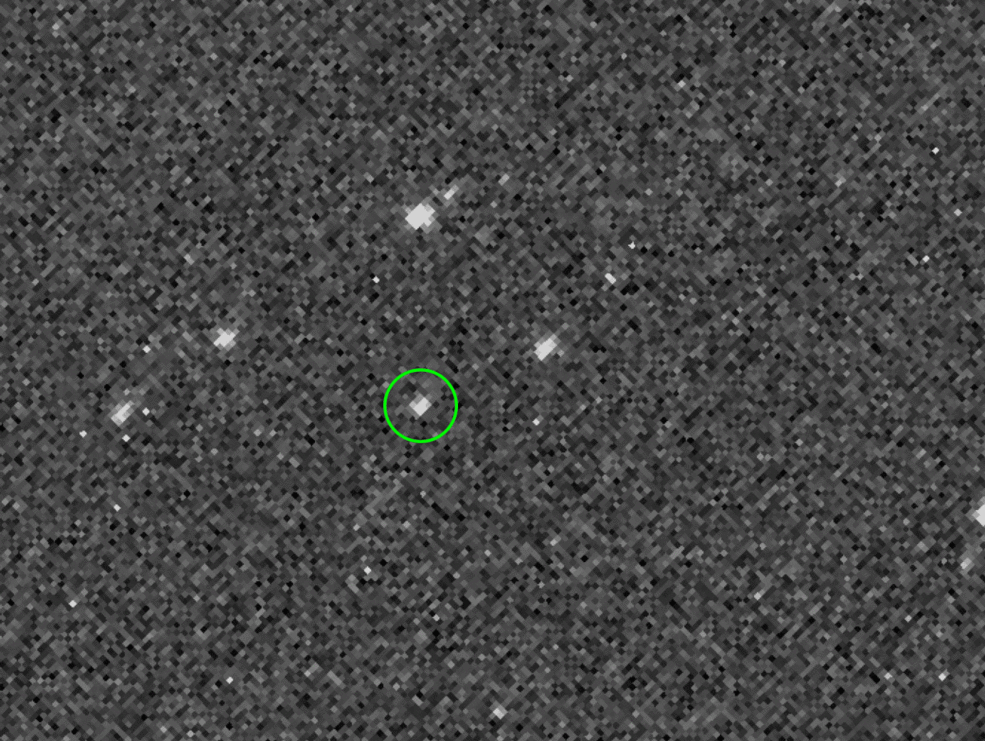
On Aug. 17, 2018 the OSIRIS-REx spacecraft obtained the first images of its target asteroid Bennu from a distance of 1.4 million miles (2.2 million km), or almost six times the distance between the Earth and Moon. This cropped set of five images was obtained by the PolyCam camera over the course of an hour for calibration purposes and in order to assist the mission’s navigation team with optical navigation efforts. Bennu is visible as a moving object against the stars in the constellation Serpens. Credits: NASA/Goddard/University of Arizona
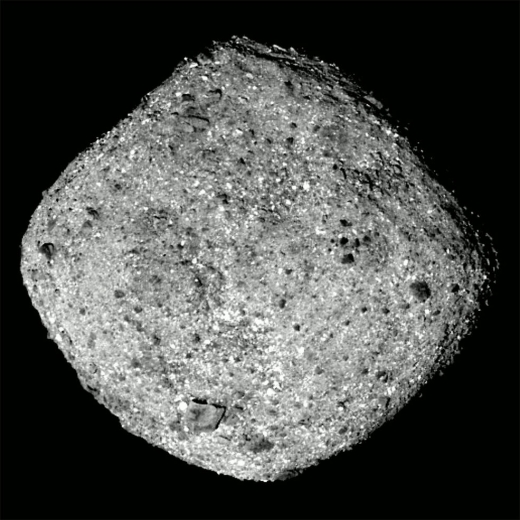
Image: Bennu in an image taken by the OSIRIS-REx spacecraft from a distance of around 80 kilometers (50 miles). Credit: NASA/Goddard/University of Arizona.
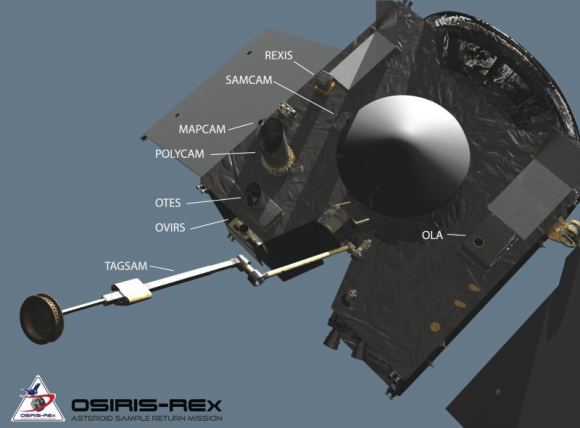
OSIRIS-REx and its instruments. Image: NASA/University of Arizona Lots of spacecraft have cameras and spectrometers, and laser altimeters are becoming more common, but the main focus of OSIRIS-REx is sample-return. To do that it has a specialized piece of equipment called TAGSAM, or Touch-And-Go Sample Acquisition Mechanism. TAGSAM is the heart of the spacecraft’s mission. It consists of a sampling head and an arm that is 3.35-meter (11 ft) long. The sample-return will work like this: OSIRIS-REx will slowly approach Bennu, at a speed of only 0.2 meters per second. The spacecraft will land on the asteroid within 25 meters of its selected landing spot The cameras will begin recording the sampling site and its surroundings. The sampling arm will contact the surface of Bennu for five seconds. It will release a blast of liquid nitrogen which will stir up dust. The dust will be captured in the sampler head. The sampler head is stored in the Sample-Return Capsule (SRC) and OSIRIS-REx will return to Earth. The SRC will separate from the spacecraft and enter Earth’s atmosphere, to be collected at the Utah Test and Training Range. This summary might make the mission sound simple, but of course its not. A lot has to go right for NASA to get its sample back to Earth. But NASA are the experts when it comes to landing spacecraft on other bodies, as the recent successful landing of the INSIGHT lander on Mars shows us. Let’s hope NASA gets it right again, because that small sample, between 60 and 2000 grams in weight, could provide some big answers to some big questions. Sources: NASA Press Release: OSIRIS-REx Arrives at Bennu NASA Feature: Why Bennu? 10 Reasons NASA’s OSIRIS-REx mission home page: OSIRIS-REx Overview Wikipedia Entry: OSIRIS-REx Wikipedia Entry: 101955 Bennu NASA page: Bennu Share this: 13Click to share on Facebook (Opens in new window)13Click to share on Pocket (Opens in new window)Click to share on Twitter (Opens in new window)Click to share on Google+ (Opens in new window)Click to share on LinkedIn (Opens in new window)Click to share on Tumblr (Opens in new window)Click to share on Pinterest (Opens in new window)Click to share on Reddit (Opens in new window)Click to print (Opens in new window)More Like this: CATEGORIESASTEROIDS, MISSIONS, NASA TAGSASTEROID, ASTEROID BENNU, ASTEROID SAMPLE RETURN, ASTEROIDS, BENNU, NASA, OSIRIS-REX, SOLAR SYSTEM Leave a Reply You must be logged in to post a comment. This site uses Akismet to reduce spam. Learn how your comment data is processed. Post navigation Previous Post PREVIOUS Micrometeorite Damage Under the Microscope Member Log in Join our Patreon community Join our 836 patrons! See no ads on this site, see our videos early, special bonus material, and much more. Join us at patreon.com/universetoday Get our new book! Search for: Search … Search Home Members Guide to Space Carnival Photos Videos Forum Contact Privacy FOLLOW US Twitter Instagram YouTube Facebook RSS Feed Twitch
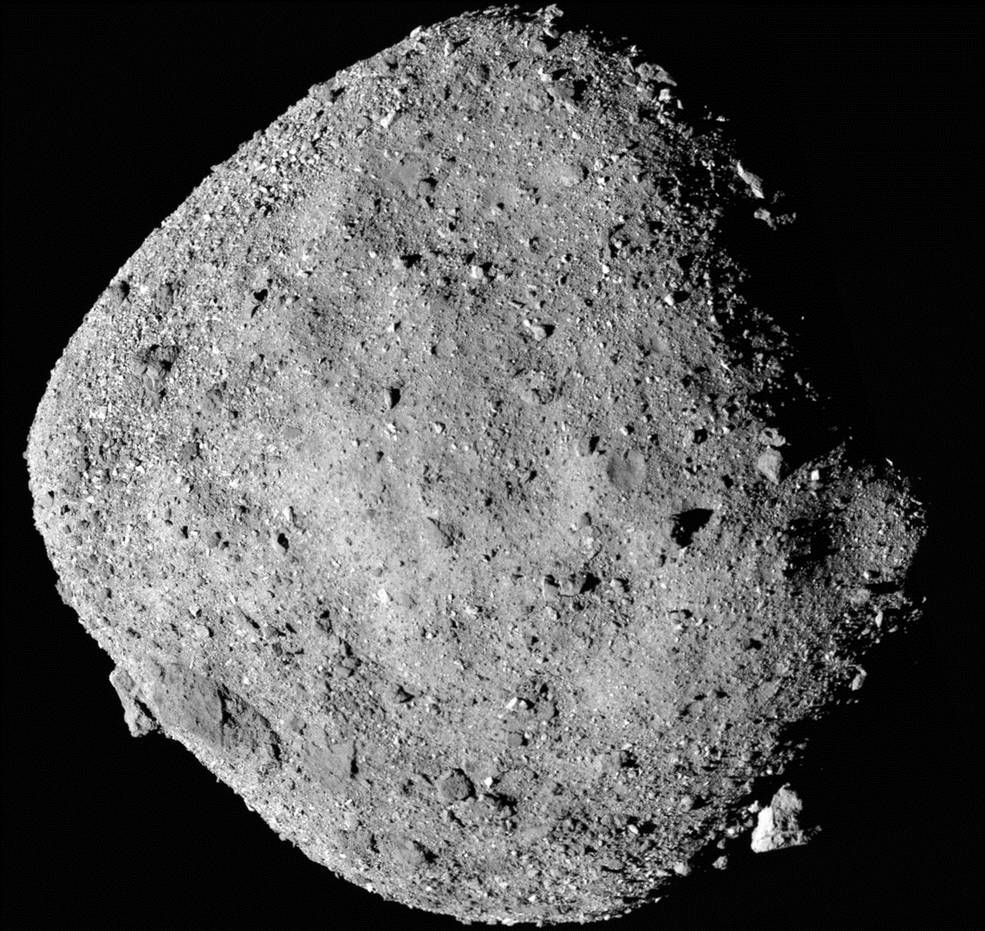
The asteroid Bennu from a distance of 24 km (15) miles captured by the PolyCam on OSIRIS-REx. The spacecraft has detected water on Bennu. On the bottom right in the termination line is the large boulder. The image is a mosaic constructed of 12 images. Image Credit: NASA/Goddard/University of Arizona.
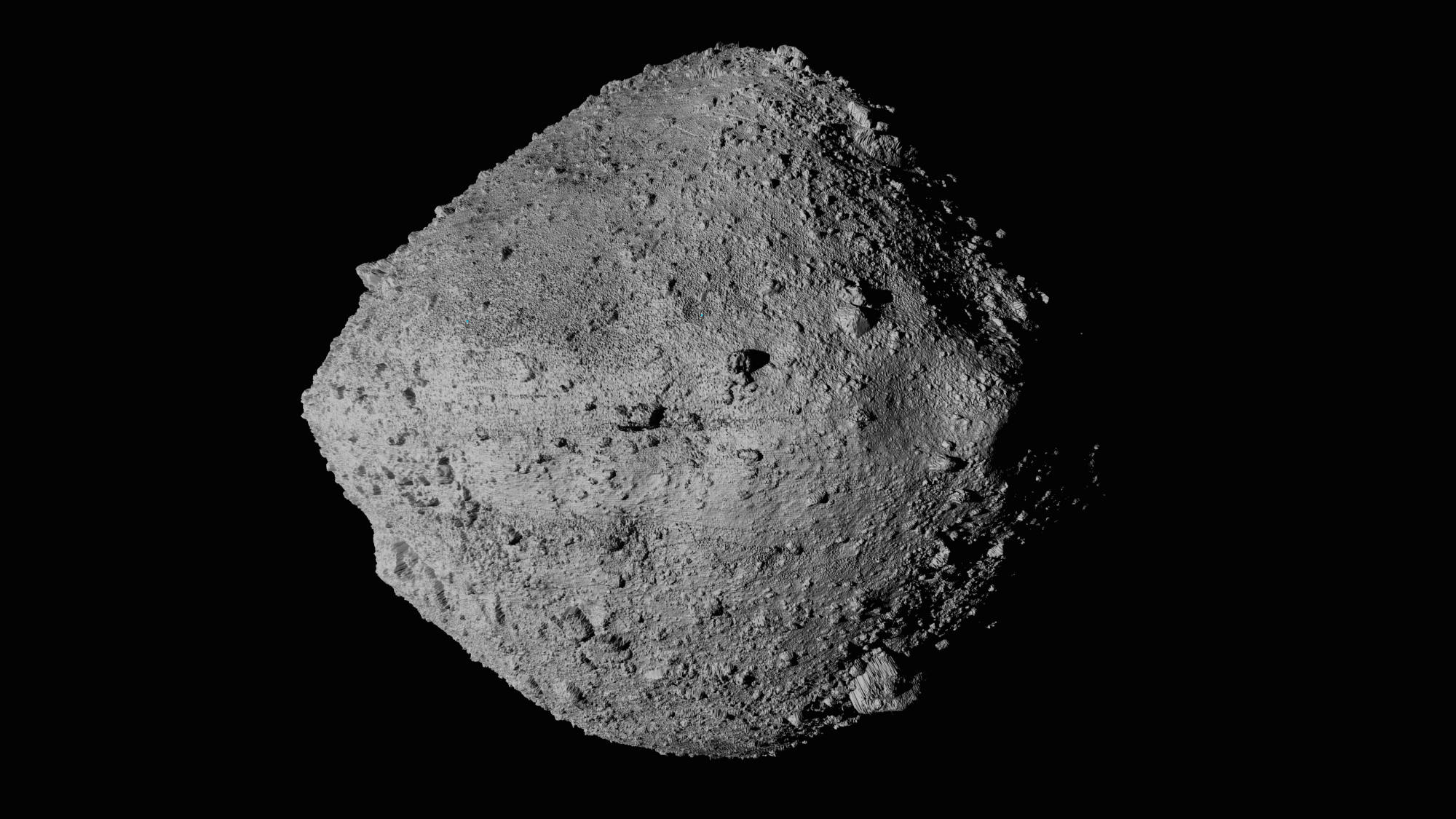
I recently mentioned that NASA has selected four potential landing sites for OSIRIS-REx to nab a sample from the surface of Bennu. A big part of this is all thanks to the hard work by the volunteers on the Cosmoquest Bennu Mappers project, who scoured images of the surface of Bennu, mapping out all the rocks. Over the course of 91 days when the images started to roll in, volunteers put in 1409 days of effort cataloging 4509 separate images (15 times each for redundancy). Are you interested in getting directly involved in science, contributing to real missions going on out in space? Then you should join up with Cosmoquest. Now that Bennu Mappers is wrapped up, we're getting the next project lined up. We've mapped Mercury, Mars, the Moon and an asteroid. What's next? Join up, and you'll be notified when it's time to do science. And to everyone who put in hours and hours and days and days of time... thank you! Thanks! Fraser Cain Publisher Universe Today
This preliminary shape model of asteroid Bennu was created from a compilation of images taken by OSIRIS-REx’s PolyCam camera during the spacecraft’s approach toward Bennu during the month of November. 2018, This 3D shape model shows features on Bennu as small as six meters. More:
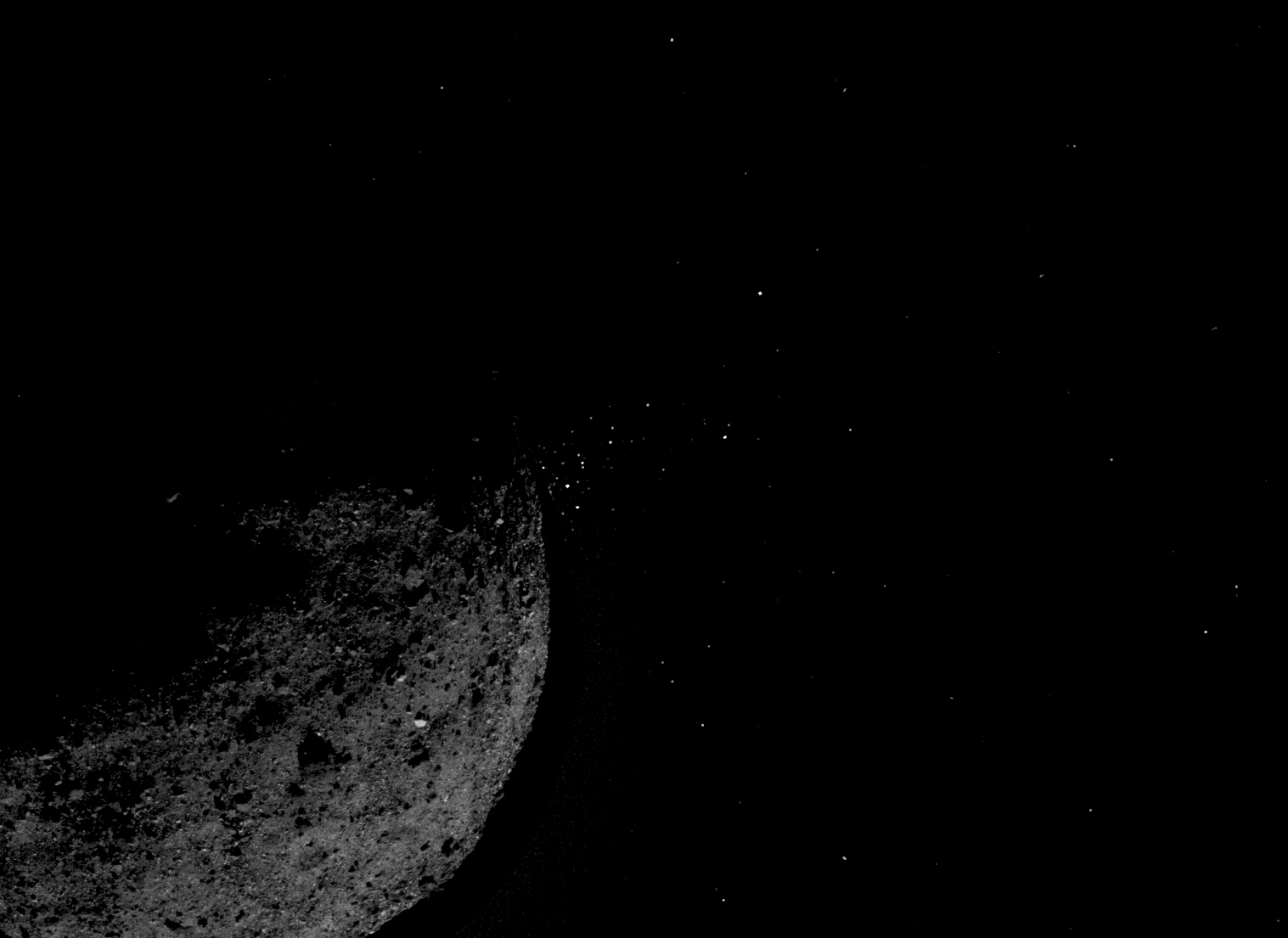
On Dec. 31st,2018 NASA’s Origins, Spectral Interpretation, Resource Identification, Security-Regolith Explorer (OSIRIS-REx) rendezvoused with the asteroid 101955 Bennu. As part of an asteroid sample-return mission, NASA hopes that material from this near-Earth Asteroid (NEA) will reveal things about the history of the Solar System, the formation of its planets, and the origins of life on Earth.
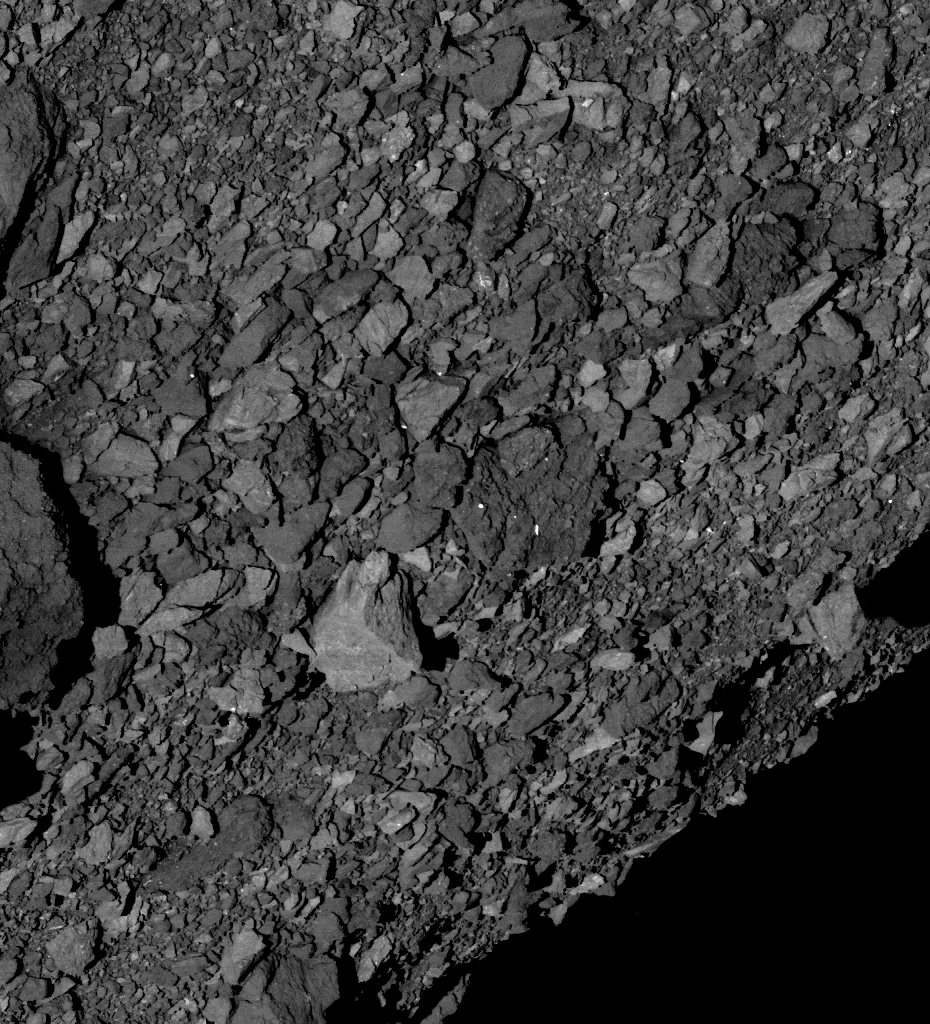
Image obtained on March 7, 2019 by the PolyCam camera on NASA’s OSIRIS-REx spacecraft from a distance of about 5 km (3 mi) Credit: NASA/Goddard/University of Arizona
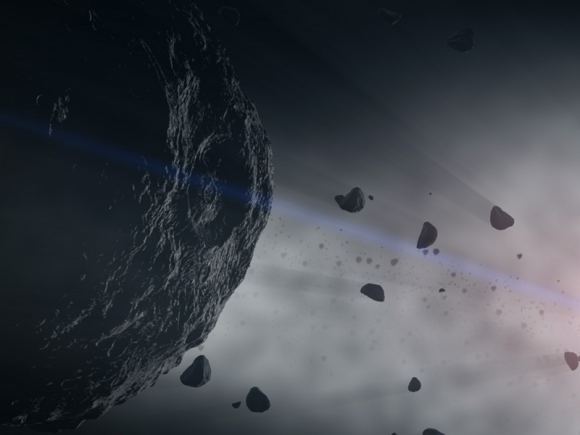
Artist’s impression of the Near-Earth Asteroid Bennu during the formation of the Solar System. Credit: NASA
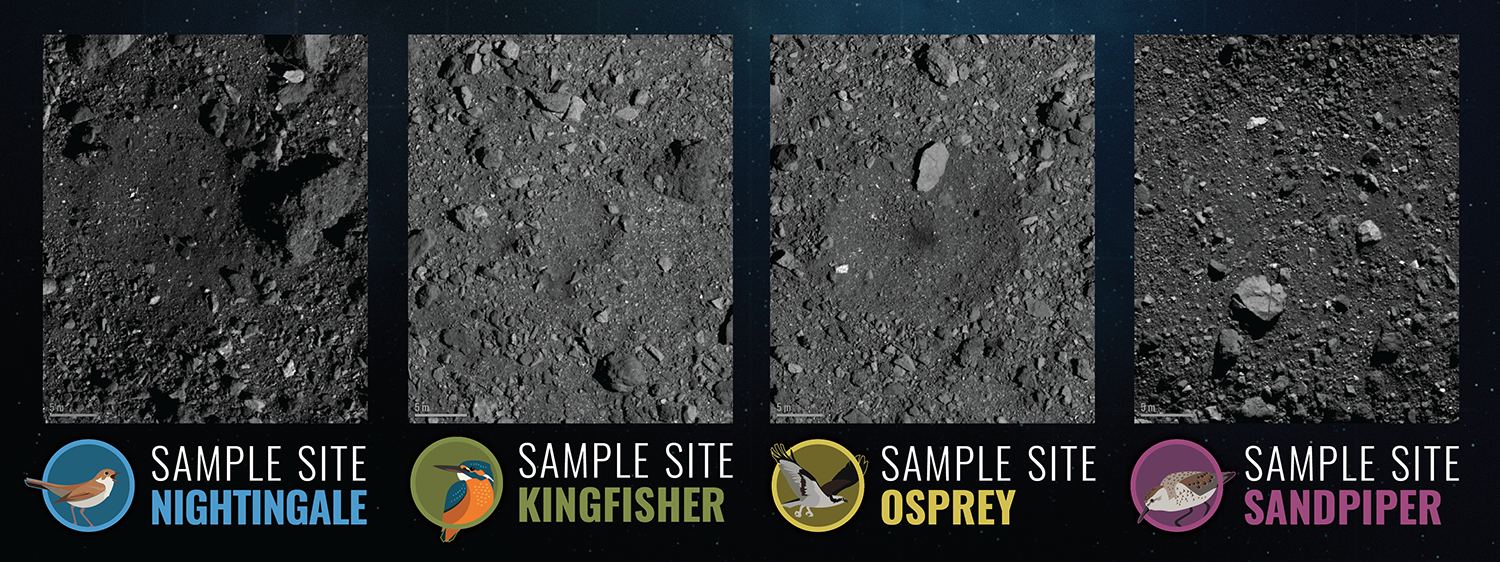
NASA’s OSIRIS-REx arrived at asteroid Bennu in December 2018. During the past year, it’s been imaging the surface of the asteroid extensively, looking for a spot to take a sample from. Though the spacecraft has multiple science objectives, and a suite of instruments to meet them, the sample return is the key objective.
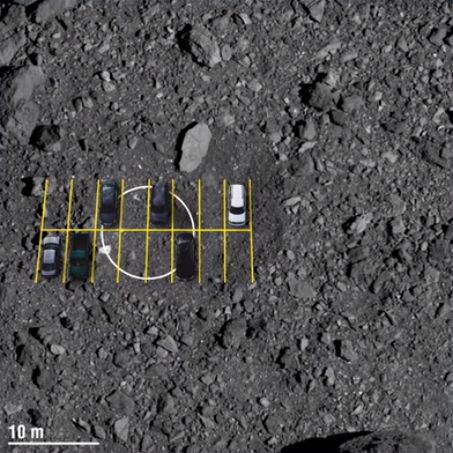
One of the four potential sampling sites with a parking lot overlaid for scale. Image Credit: NASA/Goddard/University of Arizona
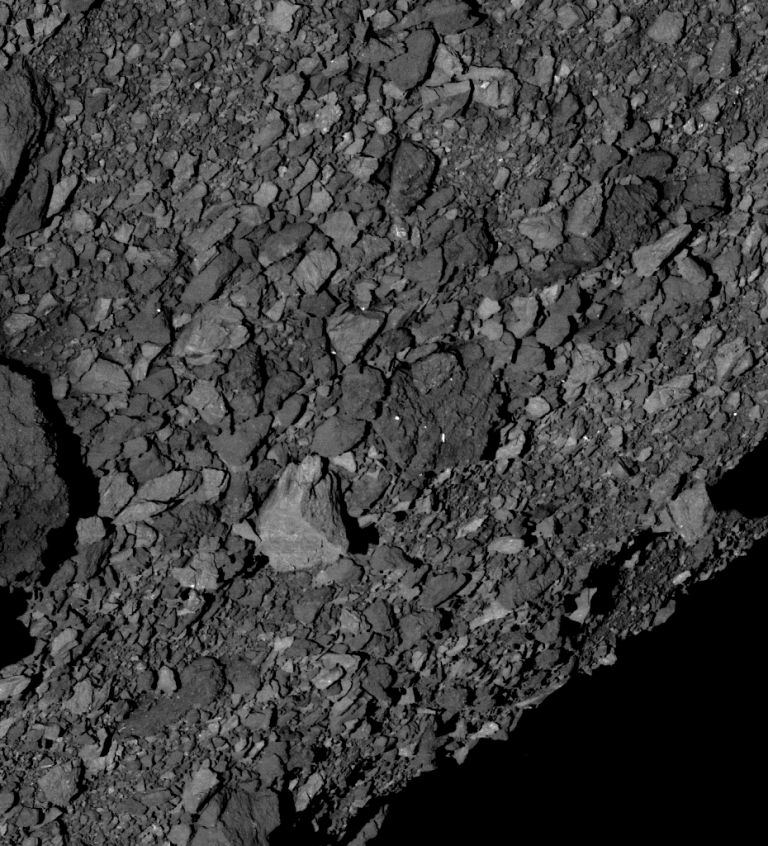
This image shows a view across asteroid Bennu’s southern hemisphere and into space, and it demonstrates the number and distribution of boulders across Bennu’s surface. The image was obtained on Mar. 7 by the PolyCam camera on NASA’s OSIRIS-REx spacecraft from a distance of about 3 miles (5 km). The large, light-colored boulder just below the center of the image is about 24 feet (7.4 meters) wide, which is roughly half the width of a basketball court. Image Credit: NASA/Goddard/University of Arizona

This flat projection mosaic of asteroid Bennu shows the relative locations of the four candidate sample collection sites on the asteroid: Nightingale, Kingfisher, Osprey and Sandpiper. NASA’s OSIRIS-REx spacecraft is scheduled to touch down on one of these four sites to collect a sample in summer 2020. Credits: NASA/Goddard/University of Arizona
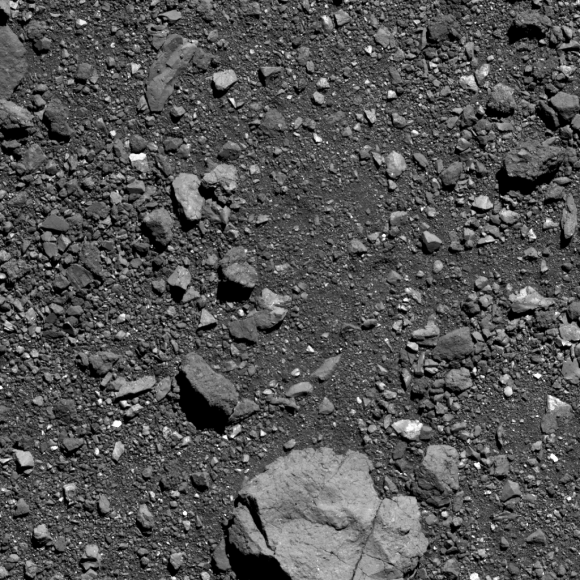
Site Sandpiper is located in asteroid Bennu’s southern hemisphere, and the region of interest is visible in the center of the image (situated above the large boulder). The image was taken by the PolyCam camera on NASA’s OSIRIS-REx spacecraft on October 5,2019 from a distance of 0.6 miles (1 km). The field of view is 48 ft (14.6 m). For scale, the large, light colored boulder in the bottom center of the image is 16 ft (5 m) wide, which is about the size of a box truck. Image Credit: NASA/Goddard/University
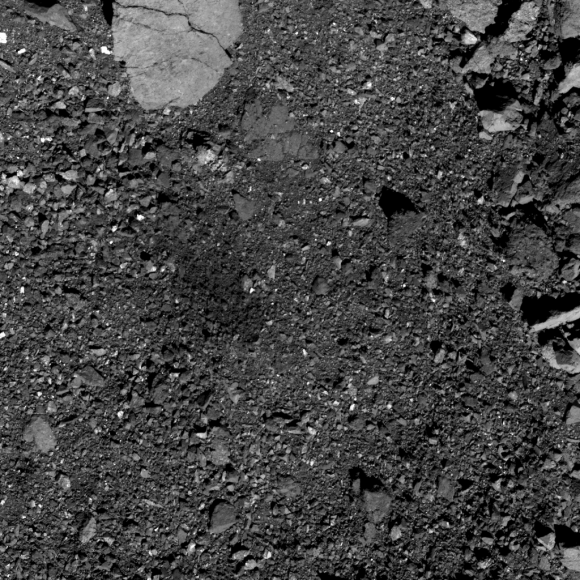
Site Osprey is located near asteroid Bennu’s equator in the northern hemisphere. Because the region of interest is so large, only a portion of the crater is shown in this image. Site Osprey’s recognizable features are visible – there is a dark patch of material in the center of the crater, and a large, flat boulder on the northern crater wall (upper left). The image was taken by the PolyCam camera on NASA’s OSIRIS-REx spacecraft on October 12, from a distance of 0.6 miles (1 km). The field of view is 47 ft (14.2 m). For reference, the fracture in the large boulder (upper left) is 10 ft (3 m) long, which is about the length of a standing grizzly bear. Image Credit: NASA/Goddard/University of Arizona
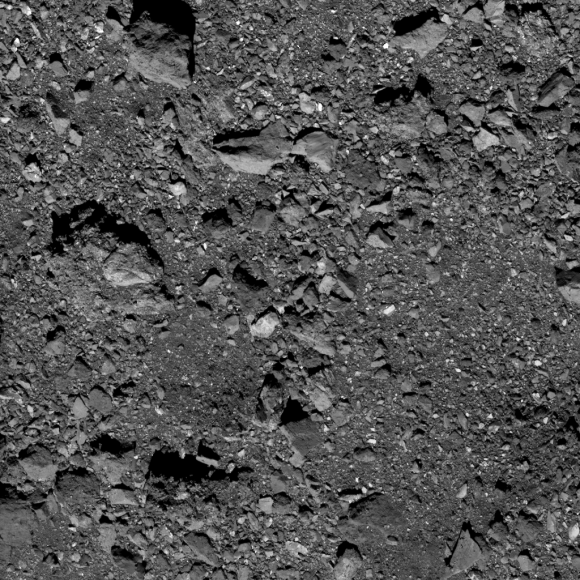
Site Kingfisher is located near asteroid Bennu’s equator in the northern hemisphere. The site itself is visible in the lower right of the image, located in the middle of the relatively clear space. The image was taken by the PolyCam camera on NASA’s OSIRIS-REx spacecraft on October 19, from a distance of 0.6 miles (1 km). The field of view is 47 ft (14.4 m). For reference, the small crater is 9 ft (2.7 m) across, which is about the length of a dolphin. Image Credit: NASA/Goddard/University of Arizona
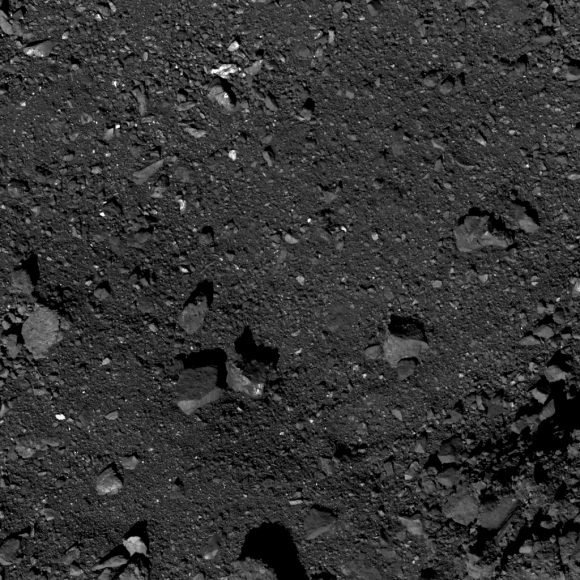
Site Nightingale is located near asteroid Bennu’s north pole. The crater’s center is visible in the top center of the image, which contains an accumulation of smaller rocks. The image was taken by the PolyCam camera on NASA’s OSIRIS-REx spacecraft on October 26 2019 , from a distance of 0.6 miles (1 km). The field of view is 47 ft (14.4 m). For reference, the light-colored boulder (far left center) is 5 ft (1.4 m) long, which is about the length of a bicycle. Image Credit: NASA/Goddard/University of Arizona
The OSIRIS-REx team has already pushed the boundaries of scientific exploration -- going from ground-based radar images from Arecibo in Puerto Rico all the way to orbiting a few hundred meters from asteroid Bennu. The team is mere months away from a sample collection attempt at the asteroid surface. Before this attempt, we take a look back at some of the major achievements, surprises and challenges of sampling an asteroid with OSIRIS-REx. Learn more: Music: "Growing Idea" from Universal Production Music Credits: NASA's Goddard Space Flight Center James Tralie (ADNET): Lead Producer Lead Editor Animator Narrator Aaron E. Lepsch (ADNET): Technical Support Michael Lentz (USRA): Animator Lisa Poje (USRA): Animator Bailee DesRocher (USRA): Animator Walt Feimer (KBRwyle): Lead Animator Kel Elkins (USRA): Data Visualizer Adriana Manrique Gutierrez (USRA): Animator Josh Masters (Freelance): Animator This video is public domain and along with other supporting visualizations can be downloaded from the Scientific Visualization Studio at: If you liked this video, subscribe to the NASA Goddard YouTube channel: Follow NASA’s Goddard Space Flight Center · Instagram · Twitter NASA GODDARD · Twitter NASA GODDARD PICS · Facebook: · Flickr
P>
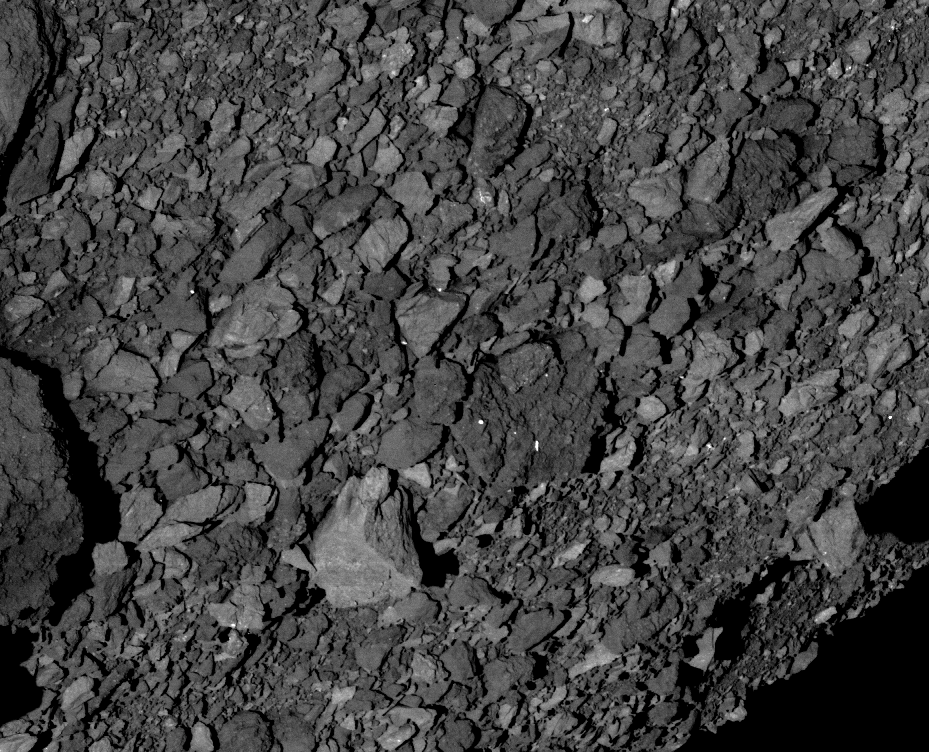
NASA’s OSIRIS-REx spacecraft reached its target, asteroid Bennu (101955 Bennu), on December 3rd, 2018. Since then, the spacecraft has been examining the asteroid’s surface, looking for a suitable landing spot to collect a sample. The problem is, Bennu has a much rockier and challenging surface than initially thought.
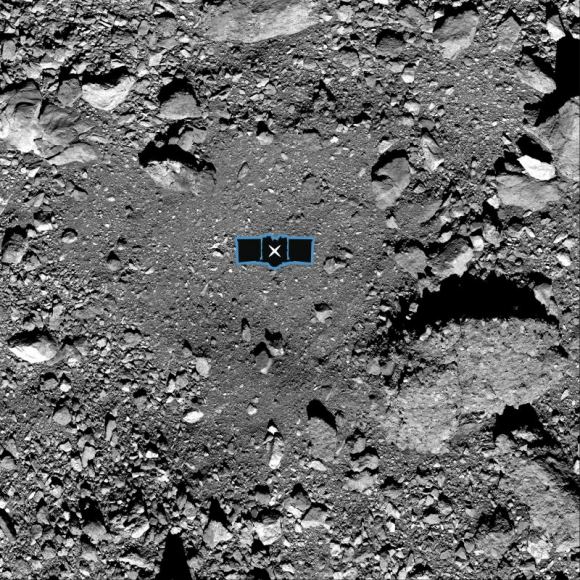
NASA chose Nightingale as Bennu’s primary sampling site. It’s relatively free from boulders and has the right size material for sampling. Image Credit: NASA/Goddard Space Flight Center
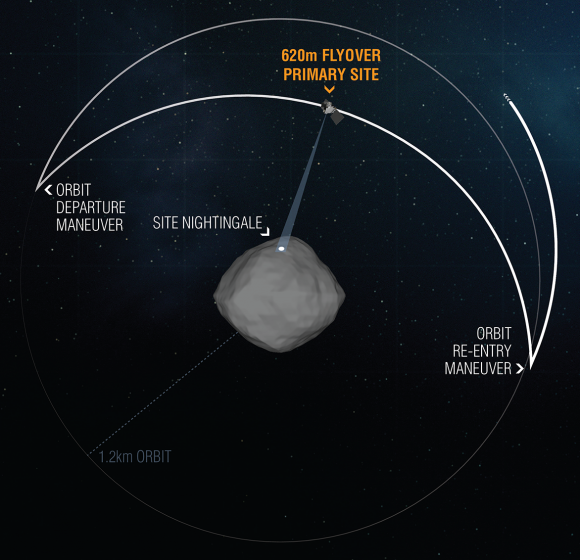
During the OSIRIS-REx Reconnaissance B flyover of primary sample collection site Nightingale, the spacecraft left its safe-home orbit to pass over the sample site at an altitude of 0.4 miles (620 m). The pass, which took 11 hours, gave the spacecraft’s onboard instruments the opportunity to take the closest-ever science observations of the sample site. Credits: NASA/Goddard/University of Arizona
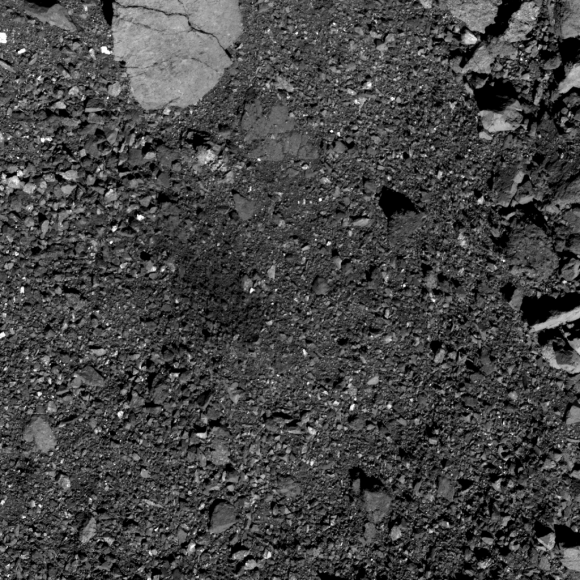
OSIRIS-REx’s backup sampling site Osprey on asteroid Bennu. Image Credit: NASA/GSFC
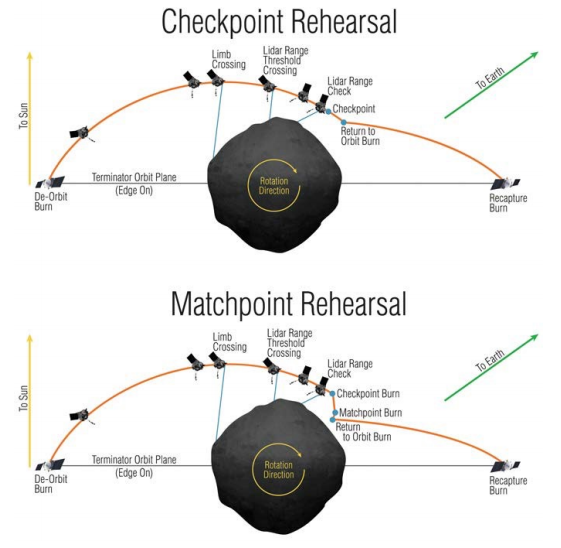
OSIRIS-REx will perform two sampling rehearsals before it performs the actual sampling maneuver. Image Credit: Lauretta et al 2017
The main science goal of NASA's OSIRIS-REx mission is to briefly touch down on near-Earth asteroid Bennu and collect a sample of fine-grained material, but the asteroid’s unexpected roughness could pose a hazard to the spacecraft. After a year of scoping out Bennu’s boulder-scattered surface, the OSIRIS-REx team has officially selected a sample collection site. The team concluded that a site designated “Nightingale” – located in a crater high in Bennu’s northern hemisphere – is the best spot for the OSIRIS-REx spacecraft to snag its sample. Nightingale’s regolith – or rocky surface material – is dark, and images show that the crater is relatively smooth. Because it is located so far north, temperatures in the region are lower than elsewhere on the asteroid and the surface material is well-preserved. The crater also is thought to be relatively young, and the regolith is freshly exposed. This means that the site would likely allow for a pristine sample of the asteroid, giving the team insight into Bennu’s history. OSIRIS-REx will collect its sample of Bennu in mid-2020, and return it to Earth in late 2023. Learn more about sample site Nightingale: Learn more about OSIRIS-REx: Credit: NASA/Goddard/University of Arizona/CSA/York University/MDA Visualization Credits Kel Elkins (USRA): Visualizer Dan Gallagher (USRA): Producer Erin Morton (University of Arizona): Communications Lead Nancy Neal-Jones (NASA/GSFC): Communications Lead Ian Jones (ADNET): Technical Support Eric Sokolowsky (GST): Technical Support This video is public domain and along with other supporting visualizations can be downloaded from the Scientific Visualization Studio at: If you liked this video, subscribe to the NASA Goddard YouTube channel: Follow NASA’s Goddard Space Flight Center · Instagram · Twitter GODDARD · Twitter NASA PICS · Facebook: · Flickr
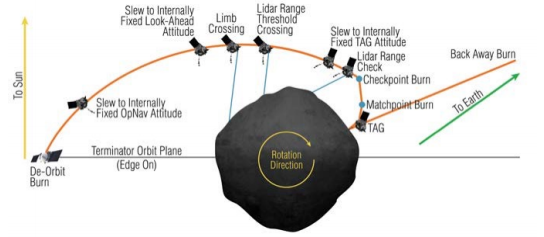
A diagram of the actual sampling maneuver. Image Credit: Lauretta et al 2017
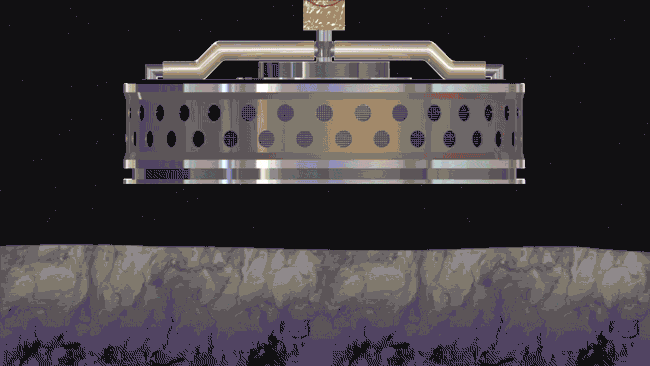
An animation of the TAGSAM collecting a sample from Bennu.
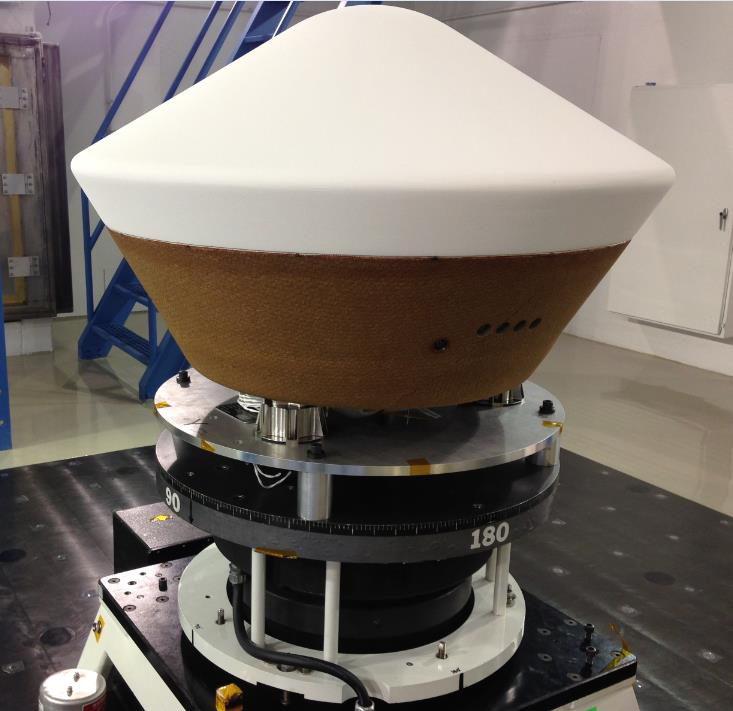
OSIRIS-REx’s Sample Return Capsule is an aero-shell design container with a heat shield and parachutes to manage its re-entry into Earth’s atmosphere. Image Credit: NASA/Goddard Space Flight Center
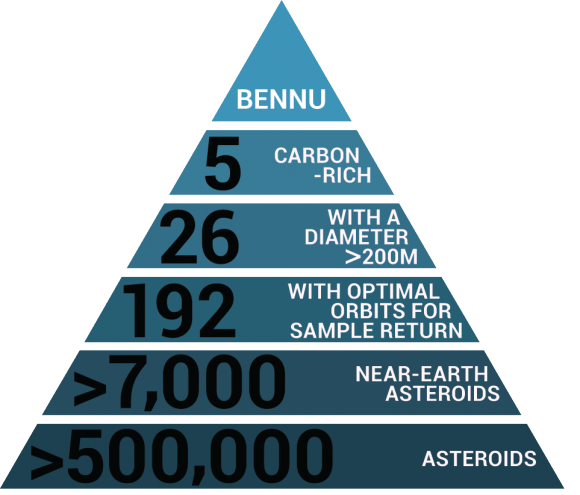
The OSIRIS-REx target selection pyramid. Image Credit: NASA/Goddard Space Flight Center.
OSIRIS-REx – Asteroid Bennu Sample Site Flyovers
<
Scientific Visualization Studio youtube channel 11.7K subscribers When NASA’s OSIRIS-REx spacecraft arrived at asteroid Bennu in December 2018, its close-up images confirmed what mission planners had predicted nearly two decades before: Bennu is made of loose material weakly clumped together by gravity, and shaped like a spinning top. This major validation, however, was accompanied by a major surprise. Scientists had expected Bennu’s surface to consist of fine-grained material like a sandy beach, but instead OSIRIS-REx was greeted by a rugged world littered with boulders – the size of cars, the size of houses, the size of football fields. The main science goal of OSIRIS-REx is to briefly touch down on Bennu and collect a sample for return to Earth, but the asteroid’s unexpected roughness could pose a hazard to the spacecraft. Areas for safely touching down are fewer and smaller than anticipated, and OSIRIS-REx will have to navigate to them with unprecedented accuracy. Now, mission planners have identified four candidate sample collection sites, and named them after birds that can be found in Egypt: Osprey, Kingfisher, Nightingale, and Sandpiper. In mid-2020, OSIRIS-REx will descend to one of these sites, and collect a sample of pristine material from the origins of the solar system that will be studied on Earth for decades to come. The 3D animations on this page were created using laser altimetry data and imagery of Bennu taken by OSIRIS-REx. The animations are available in Hyperwall resolution (5760x3240). Global view of asteroid Bennu with insets of the four candidate sample collection sites. This animation is available in Hyperwall resolution (5760x3240). Please give credit for this item to: NASA's Scientific Visualization Studio Data provided by NASA/University of Arizona/CSA/York University/MDA. Visualizer: Kel Elkins (lead) For more information or to download this public domain video, go to
Bennu Global Mosaic
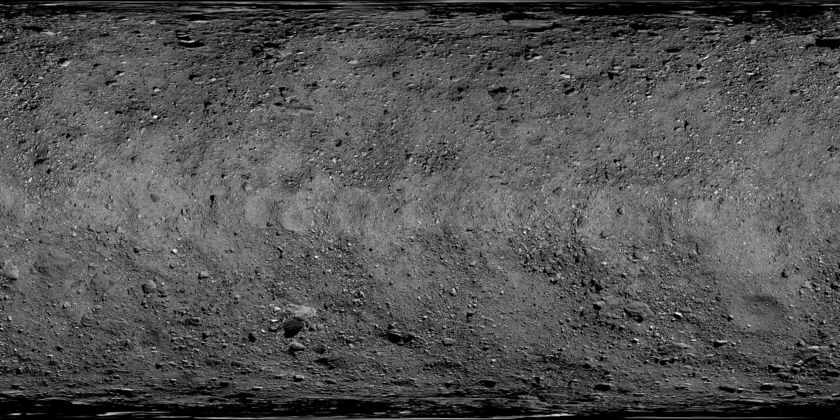
BENNU GLOBAL MOSAIC This global map of asteroid Bennu was created using more than 2,000 images captured by NASA's OSIRIS-REx spacecraft in 2019. You can download full-resolution versions of the map here. The resolution is 5 centimeters per pixel, the highest resolution at which a planetary body has been globally mapped. Credit:NASA/Goddard/University of Arizona
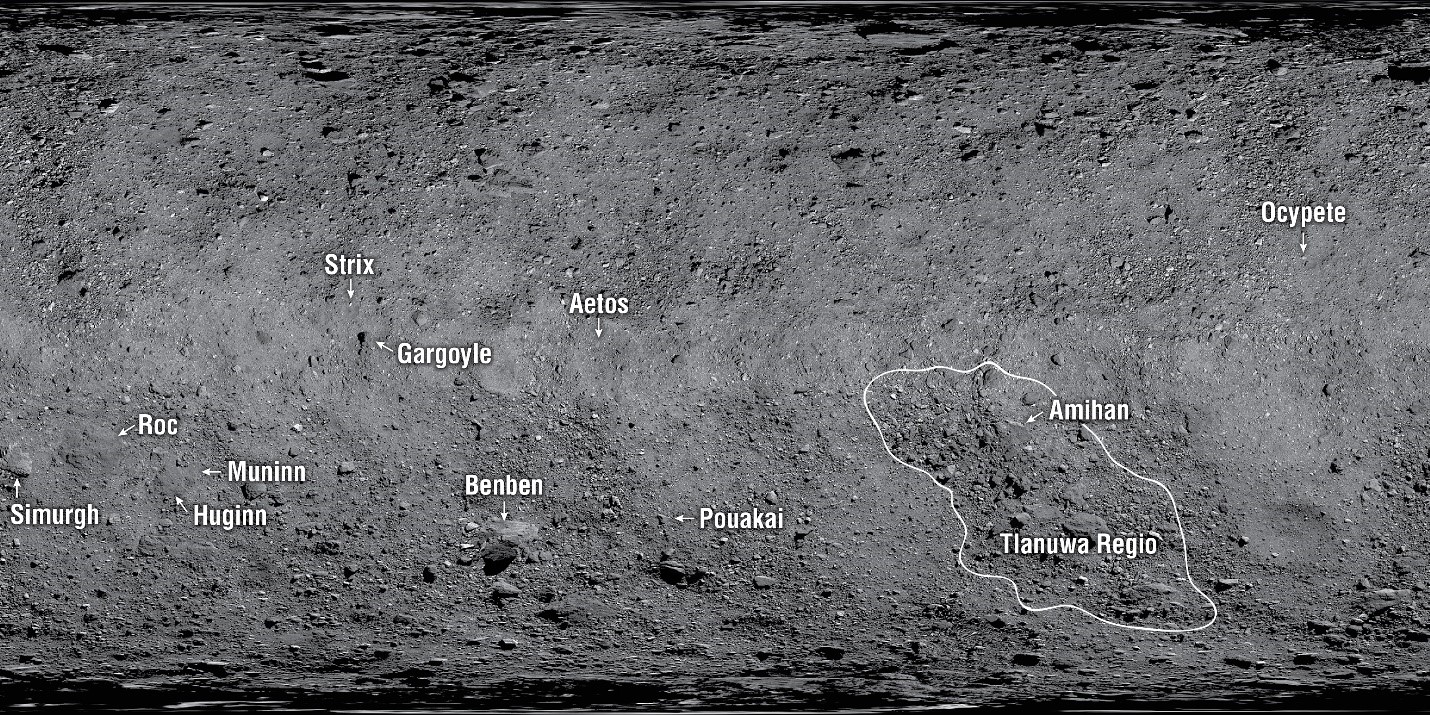
Late last summer, NASA and the International Astronomical Union’s Working Group for Planetary System Nomenclature (a.k.a WGPSN) approved the naming convention for features on Bennu, the asteroid currently being orbited and studied by the OSIRIS-Rex spacecraft. The naming theme chosen was “birds and bird-like creatures in mythology.”
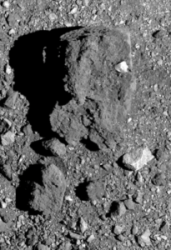
Gargoyle Saxum is named for the French dragon-like monster with wings, bird-like neck, and the ability to breathe fire. Gargoyle Saxum is a large prominent boulder near the mission’s backup sample site that is one of the darkest objects on the surface. Credit: NASA/Goddard/University of Arizona.
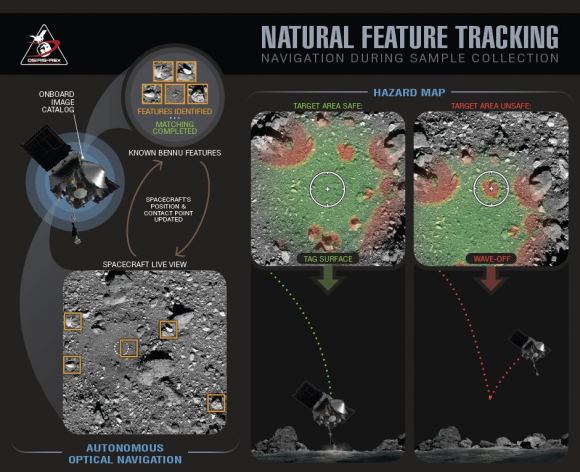
During the sample collection event, Natural Feature Tracking (NFT) will guide NASA’s OSIRIS-REx spacecraft to asteroid Bennu’s surface. The spacecraft takes real-time images of the asteroid’s surface features as it descends, and then compares these images with an onboard image catalog. The spacecraft then uses these geographical markers to orient itself and accurately target the touchdown site. Credit: NASA/Goddard/University of Arizona
In late August, the OSIRIS-REx spacecraft will navigate to asteroid Bennu’s surface for its first sample collection attempt. To do this, it will use an onboard image software known as Natural Feature Tracking (NFT) — a form of optical navigation that is completely autonomous. NFT guides the spacecraft by comparing an onboard image catalog with the real-time navigation images it takes during descent, looking for specific landmarks on Bennu’s surface in order to orient itself. This navigation technique allows the spacecraft to accurately target small sites while dodging potential hazards. Music Credit: "Steppenwolf" from Universal Production Music. Credit: NASA's Goddard Space Flight Center James Tralie (ADNET): Lead Producer Lead Animator Lead Editor Krystofer Kim (USRA): Animator Kel Elkins (USRA): Visualizer Michael Moreau (NASA/GSFC): Scientist Kenny Getzandanner (NASA/GSFC): Scientist Ryan Olds (Lockheed Martin): Scientist Sandra Freund (Lockheed Martin): Scientist Lisa Poje (USRA): Animator Aaron E. Lepsch (ADNET): Technical Support This video is public domain and along with other supporting visualizations can be downloaded from NASA Goddard's Scientific Visualization Studio at: https://svs.gsfc.nasa.gov/13555 If you liked this video, subscribe to the NASA Goddard YouTube channel: subscribe to the NASA Goddard YouTube channel: Follow NASA’s Goddard Space Flight Center · Instagram · Twitter- NASA GODDARD · Twitter-NASA GODDARD PICS · Facebook: · Flickr Category Science & Technology
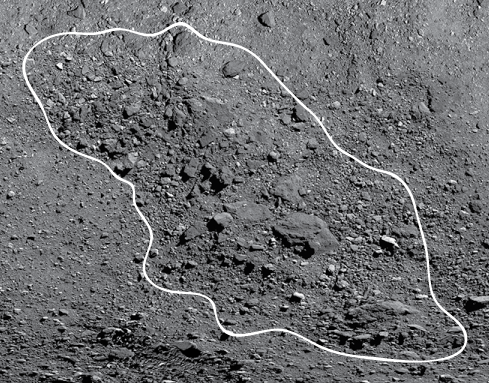
The large boulder spine in Bennu’s southern hemisphere is now called Tlanuwa Regio. It’s named for the giant birds who scattered the Earth with pieces of a serpent that turned into standing pillars of rocks in Cherokee mythology.
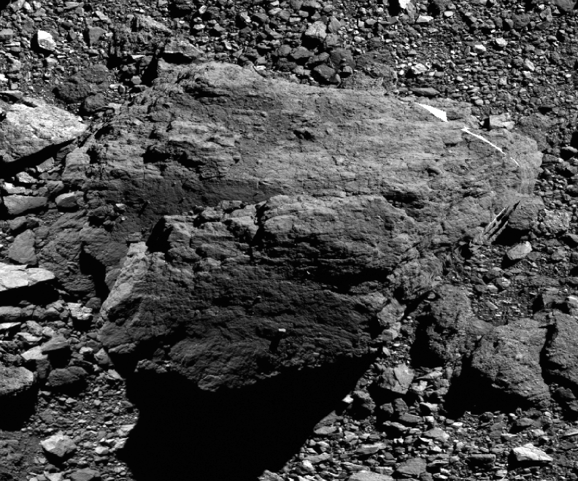
Benben Saxum is Bennu’s tallest boulder – previously known as Boulder No. 1. It’s named for an ancient mound from Egyptian mythology - the god Atum settled upon Benben to create the world after his flight over the waters in the form of the Bennu bird.
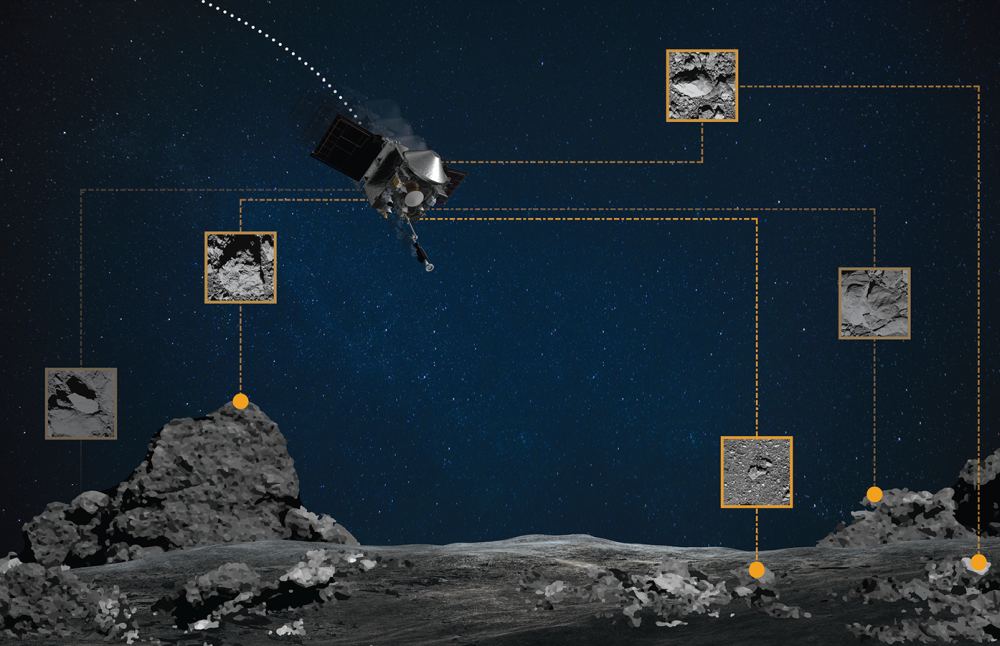
Meet OSIRIS-REx’s “Guide Boulders.” When the NASA spacecraft first arrived at asteroid Bennu over a year ago, the surface of the asteroid was much different than expected. Instead of a surface with large, smooth areas, nearly the entire surface is covered in boulders. That meant that NASA had to do a re-think of the sampling procedure.
Read all about LiDAR News- Video Courtesy: Battelle, Vision Studios, Faro, NEON Science, Mike R. Duncan, Leica Geosystems AG, LUCIAD, FARO Technologies, Inc., FARO UK, Leica Geosystems AG, RIEGL, Delta Lidar, Canada Foundation for Innovation / Fondation canadienne pour l'innovation, FARO Construction BIM, Vision Studios, True Reality Geospatial Solutions, LLC,

OSIRIS-REx’s backup sampling site Osprey on asteroid Bennu. Image Credit: NASA/GSFC
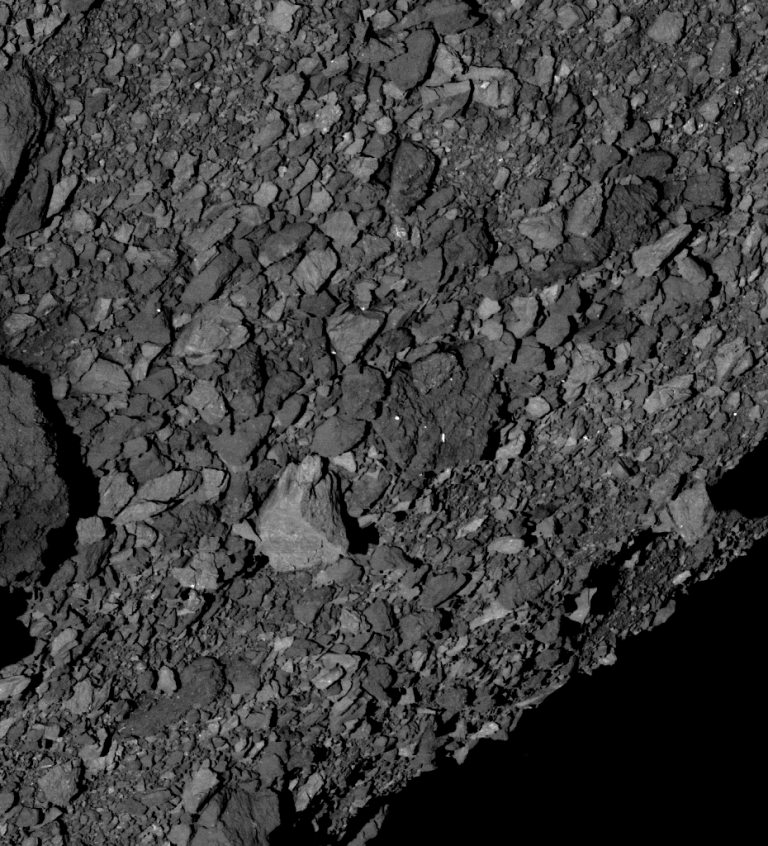
Bennu’s boulder-strewn surface. Image Credit: NASA/University of Arizona.
![]()
There are a couple rehearsal sampling operations coming up, and OSIRIS-REx will use NFT during those close approaches. The OSIRIS-REx team will monitor the effectiveness of the NFT, and to see if the spacecraft can even abort an approach if necessary. This will all happen automatically, since Bennu is too far away for real-time communication.
In late August, the OSIRIS-REx spacecraft will navigate to asteroid Bennu’s surface for its first sample collection attempt. To do this, it will use an onboard image software known as Natural Feature Tracking (NFT) — a form of optical navigation that is completely autonomous. NFT guides the spacecraft by comparing an onboard image catalog with the real-time navigation images it takes during descent, looking for specific landmarks on Bennu’s surface in order to orient itself. This navigation technique allows the spacecraft to accurately target small sites while dodging potential hazards. Music Credit: "Steppenwolf" from Universal Production Music. Credit: NASA's Goddard Space Flight Center James Tralie (ADNET): Lead Producer Lead Animator Lead Editor Krystofer Kim (USRA): Animator Kel Elkins (USRA): Visualizer Michael Moreau (NASA/GSFC): Scientist Kenny Getzandanner (NASA/GSFC): Scientist Ryan Olds (Lockheed Martin): Scientist Sandra Freund (Lockheed Martin): Scientist Lisa Poje (USRA): Animator Aaron E. Lepsch (ADNET): Technical Support This video is public domain and along with other supporting visualizations can be downloaded from NASA Goddard's Scientific Visualization Studio at: https://svs.gsfc.nasa.gov/13555 If you liked this video, subscribe to the NASA Goddard YouTube channel: subscribe to the NASA Goddard YouTube channel: Follow NASA’s Goddard Space Flight Center · Instagram · Twitter- NASA GODDARD · Twitter-NASA GODDARD PICS · Facebook: · Flickr Category Science & Technology
You may have heard about a NASA probe that successfully brought some samples from a deep-space asteroid back to Earth. It took four billion miles to get them, but researchers believe it will be worth it. You also may be wondering just why scientists want these samples from what's essentially a huge rock flying through space. Science correspondent Miles O'Brien explains. : Stream your PBS favorites with the PBS app Find more from PBS NewsHour at Subscribe to our YouTube channel: Follow us: TikTok: Twitter: Instagram: Facebook: Subscribe: PBS NewsHour podcasts: : Newsletters
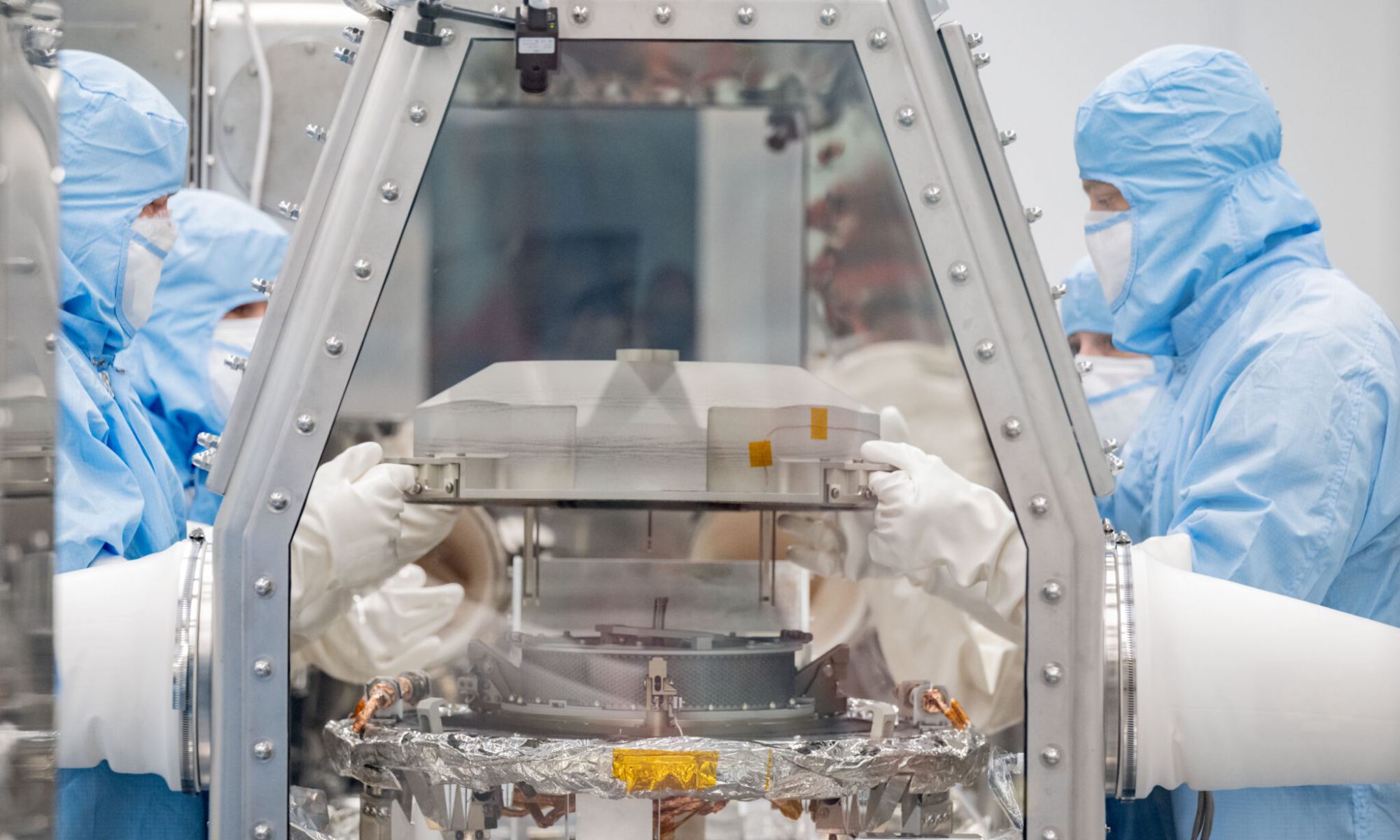
OSIRIS REx Asteroid Sample Return lid opening at Building 31 Astromaterials Curation Facility at the Johnson Space Center. Credit: NASA/Robert Markowitz
This (silent) animation shows the OSIRIS-REx spacecraft deploying its Touch and Go Sample Acquisition Mechanism (TAGSAM) to collect a sample of regolith (loose rocks and dirt) from the surface of asteroid Bennu. The sampler head, with the regolith safely inside, is then sealed up in the spacecraft's Sample Return Capsule, which will be returned to Earth on Sept. 24, 2023. Scientists will study the sample for clues about the early solar system and the origins of life. Credit: NASA Goddard
Thanks to the Planetary Society Planetary Society
Thanks to the Bruce Murray Image Library of the Planetary Society Planetary Society